- For Sale/Wanted
- Readers Tips
- Your Yarns.
- Restoration
- Miscellaneous
- DIY Boat Yards
- Boat Building
- Cabin Cruisers
- Free Boat Plans
- Begin Boating
- Boating Terms
- Ropes and Rigs
- Just for Fun
- Celestial Navigation
- Passage Planning
- VHF Marine Radio
- Diagonal Scale
Sailboat Plans

Free Sailboat Plans
A selection of some of the Free Sailboat Plans (pdf) that were published in magazines such as “Popular Mechanics”, "Popular Science" and the "Boat Builder Handbook".
If you need help with lofting out the plans click here for an article here which should help.
- Open Dayboats/Dinghys
- Rowing Boats
Open/Dayboat, Free Sailboat Plans
Everyone who digs boating has heard of the Hobie Cat, the sleek little catamaran that burst on the scene and captured the attention of all the fast-action sailors.
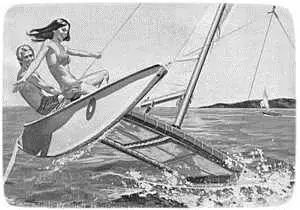
Marked by asymmetrical hulls and special trampoline supports, the Hobie can reach speeds above 20 mph and perform with a rare agility.
But it has one drawback.
It costs mucho dinero.
Thus, we introduce the Hobby Kat, sailboat plans, a build-it-yourself version of the “Hobie” that should cost from half to a third of the commercial version. If you have the moola, of course, go for a Hobie and have the time of your life on the water.
If not, try our Hobby
The homebuilt is not quite the same.
But she sails sweetly and fast—qualities which have made the “Hobie” popular
Even in a light air she’ll slip through the water at a fast clip.
She has no centreboards, leeboards or keel, and needs none.
The inside of each hull has built-in lift, like an airplane wing, so that as the boat heels and one hull digs in the boat is pulled back to windward.
Click Here for the Plans
She can run in very shallow water and the rudders kick up for beaching.
You can carry her on a trailer or even disassemble her.
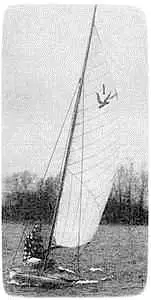
Many a “stink pot” addict will take a second look at Tern because she planes in modest breezes, is easy to handle, and her streamlined prow arid pod-shaped, “inland scow” type hull offer slight water resistance. Then too, there’s a charm about the tiller of a sailer that’s not matched by the wheel of a motor-powered boat. Part of it is the challenge of making the most of nature’s free-wheeling breezes. Even with her 72sq.ft of sail, this Free Sailboat Plan is remarkably stable, and packs as many as four persons aboard
For thousands of inland lakes, Tern is the answer to sailing water sport, she is rugged and easy to launch
And she’s remarkably easy to build.
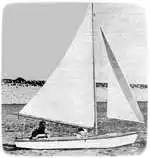
Falcon is a small, speedy, sporty sailboat which handles well. Tests on the original Falcon showed that she could easily out-distance boats of comparable size such as the one design class Snipe and Comet sailers.
And she will pace neck and neck with 18 footers with considerably greater sail spread.
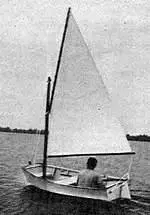
This strong, beamy, eight-foot pram may be sailed either cat-rigged or sloop-rigged.
The dagger-board may be adjusted forward to balance the helm when sailing with the addition of a jib sail.
Oars or a small outboard motor may also be used to power this versatile Free Sailboat Plans.
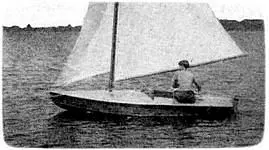
Dart” is a small two or three person sailing craft, designed for use on protected waters such as bays. lakes, rivers or wherever sheltered waters are found. Its construction will repay the builder handsomely and provide a fast sailing craft, light in weight, easily transportable and cheap to construct with all difficult joinery eliminated
It provides thrilling and economical sport.

The 'Crescent', designed by C. T. Allen, is the ideal sailboat for day sailing on a small lake, river, or protected waters of a bay.
Centreboard design (Fig. 2) reduces Crescent's draft, so Shallow is not a problem.
Its broad beam of over 5½ft. makes it an ideal family boat because there is room for a cockpit large enough to accommodate four adults or two adults and three kids, and side and forward decks big enough to stretch out on when sun bathing.
"Jewel" is a 16' Crescent Sailboat being built by Mike Allen from the free sailboat plans by C.T .Allen in the 1958 "Boat Builders Handbook". And what a superb job Mike is doing check out his photos here .
Click Here for the Free version of the Plans
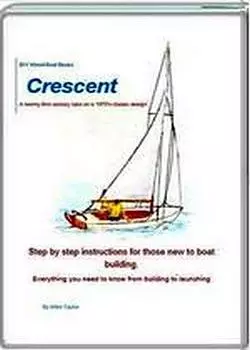
Sailing enthusiasts and backyard boat builders are not likely to find free boat plans for a sailing pram that can be built faster, lighter, stronger, or less expensively than Graefin-10. Two men can begin work on a Friday evening and have a smart, lively 10-ft. 85-pound sailboat in the water by Sunday evening (it’s been done).

Zephyr Is a refinement of a type of boat developed by the English for use in the rough open waters of the English Channel. Not only is it fast under sail, but it can stand up under punishment. And it’s light enough to be easily loaded atop an auto or light trailer.
Breeze-Baby
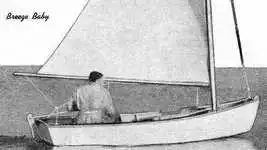
Skimming off a brisk wind or with the wind abeam, Breeze-Baby actually planes with one person aboard. Despite her rowboat lines that make her easy to build, she handles easily under her simple sail, an ideal first boat. Simple lines are adapted to plywood construction that’s strong, light and that keeps Breeze-Baby’s bilges dry
You can take her with you atop your car or on a lightweight trailer for summer fun wherever you vacation or get in a week-end’s sailing.

Cat’s Paw is easy to build because of the straight-sided hulls. The sheer line is flat and that simplifies building the form. Bow and stern are straight, so there’s no cockeyed bevel to fit and fuss with
She Is an Ideal boat to learn or practice sailing in because she will forgive so many mistakes.
Cabin Cruiser, Free Sailboat Plans
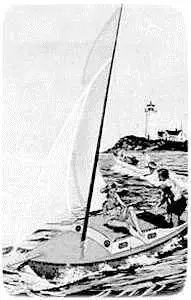
Previous posts
See What Others Have Posted

Recent Articles
Owens Boats
Jun 05, 24 12:14 PM
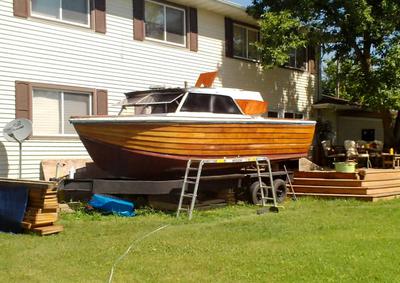
- Boat Plan Books
- Boatbuilding Tips
- Glass Cloth
- Stitch and Glue
- Strip Plank
You might like these

Knotty wood, problems with boat building timber.
Knotty wood, how to avoid structural problems with knots in lumber when using softwood timber for fitting out and boat joinery

Build a Boat, tips for the DIY Wooden Boat Builder.
How to Build a Boat, Wooden Boat Building methods for the DIY, backyard, self-builders explained, carvel, lapstrake and plywood

Wood Screws for Boat Building and Repair.
Wood Screws are the most widely used and versatile fasteners used on wooden boats. Which type to use and how to use them

Wood, Environmentally Friendly Boat Building Lumber.
Make sure that the Wood that you buy and use is sustainably grown and harvested.
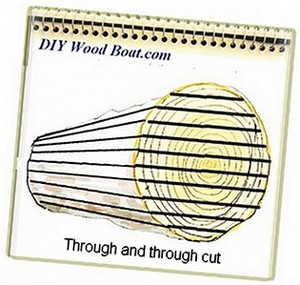
Timber, Lumber for Boat Building.
A brief description of the most common Timber used for building Wooden Boats how to choose wood for your project boat

Timber Properties
A brief guide to timber properties and wood, characteristics such as strength, stiffness and elasticity for choosing lumber for wooden boat building and restoration.
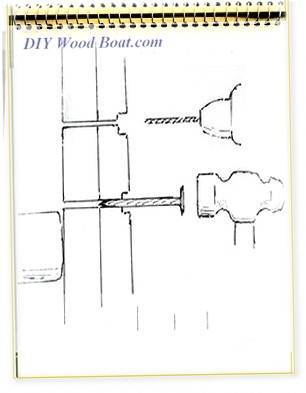
Rivets and Copper Rove Wood Boat Fastenings.
How to use Copper Rivets and Roves construction guide to fasteners on your wooden boat.

Ring Nails for Marine Fastening.
Ring Nails sometimes call Gripfast or ring shank, silicon bronze boat nails are renowned for their holding power. but how to get them out?

Plywood and Veneer Guide for Marine use.
A guide to plywood for boat building and why you should use the best marine grade you can afford.

Glue for Wooden Boat Building
Which Wood Glue to use when building or restoring a wooden boat, resorcinol to epoxy.

Rowing Boat Plans
Free Rowing Boat Plans for the backyard home builder, build your own rowing boat, dory, folding dinghy or pram using these simple plywood designs.

Free Motorboat Plans
Free Motorboat Plans for the backyard home builder, build your own speed boat, cabin cruiser, runabout or utility boat using these simple plywood designs.
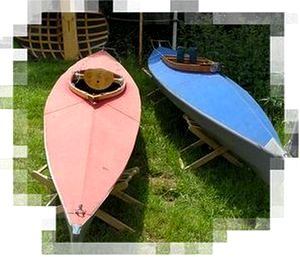
Wooden Boat Kits.
Wooden boat building is easy and inexpensive with wooden boat kits. From row boats and kayaks to sailing cruisers, boat to be proud of

Supplies for Wooden Boat building and Maintenance
Supplies for Wooden Boat Building and restoration, how to choose the materials and marine chandlery for your project.

Small Boats, Made of Wood
What Everybody ought to know about building Small Boats, guidance and tips for self-building or restoring.
Penn Yan Boats
May 28, 24 07:51 AM
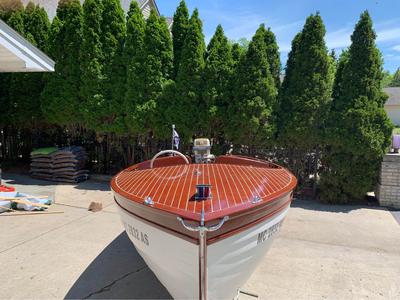
Chris Craft Boats
May 21, 24 06:16 AM
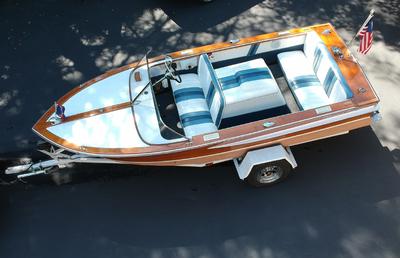
Wooden Boat Restoration, Repair and Maintainence.
Wooden boat restoration, how to fix up an old wooden boat, one of the cheapest ways to get afloat and have a boat to be proud of.

Epoxy Resin for DIY Wooden Boat Building.
A guide to the epoxy resins and sustainable enrtopy resins to use when building wooden boats with marine plywood.

Wood Rot Repair and Treatment
Wood rot in wooden boats, how to treat, repair and replace rotten timbers in a wooden boat
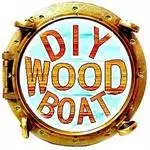
Privacy Policy
Advertising Policy
Cookie Policy

I am perfectly aware that the majority of Wooden Boat aficionados are sensible folk. However, I need to point out that I am an amateur wooden boat enthusiast simply writing in order to try to help other amateur wooden boat enthusiasts. And while I take every care to ensure that the information in DIY Wood Boat.com is correct, anyone acting on the information on this website does so at their own risk.

Learn How to Make a Miniature Sailboat | Step-by-Step Guide
Alex Morgan
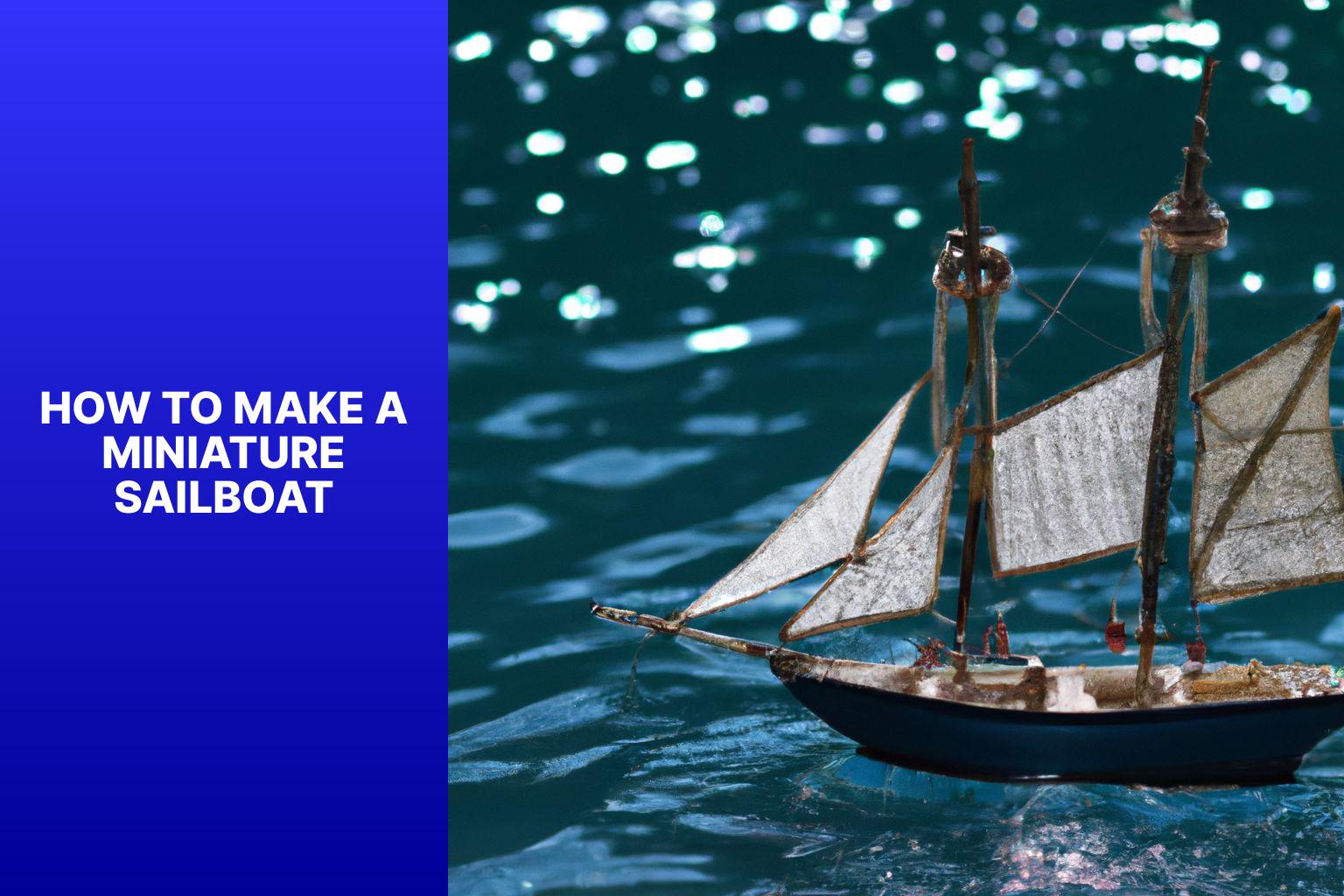
Making a miniature sailboat can be a rewarding and enjoyable hobby. Building your own miniature sailboat allows you to unleash your creativity, learn about boat construction, and have a functional piece of art. With the right materials, tools, and techniques, you can create a beautiful miniature sailboat that is both aesthetically pleasing and capable of sailing. In this article, we will guide you through the process of making a miniature sailboat, from gathering materials and tools to painting and finishing touches, testing and setting sail, as well as troubleshooting and maintenance. Let’s embark on this exciting journey of constructing your very own miniature sailboat.
Key takeaway:
- Making a miniature sailboat maximizes creativity: Building a miniature sailboat allows individuals to express their creativity and craftsmanship while creating a functional toy or decorative piece.
- Gathering the right materials and tools is crucial: The quality of the miniature sailboat depends on using the right materials and tools for each component, such as the hull, mast, sails, rigging, and accessories.
- Attention to detail enhances the finished product: Painting and adding finishing touches to the miniature sailboat, including sanding, priming, applying paint and varnish, and adding details and decorations, bring the sailboat to life and make it visually appealing.
Gather Materials and Tools
Get ready to set sail on a fantastic DIY adventure! In this section, we’ll dive into the essential steps of gathering materials and tools for creating your very own miniature sailboat. From crafting the sturdy hull to designing the mast and sails, we’ll cover all the bases. We’ll even explore the intricate details of rigging and accessories that will give your sailboat that extra touch of authenticity. So, hoist your imagination and get ready to embark on this nautical journey with us.
To create the table for the sub-topic “ 1. Hull “, the following information is provided:
| The material used for constructing the hull: wood, fiberglass, or plastic. | |
| The shape of the hull, which can vary from flat-bottomed to v-shaped or round-bottomed. | |
| The length of the hull in inches or centimeters. It determines the overall size of the miniature sailboat. | |
| The width of the hull, also known as the beam. It affects the sailboat’s stability. | |
| The keel is a fin-like structure attached to the hull’s bottom to improve stability and prevent capsizing. | |
| The lowest interior part of the hull where water collects. It is important for draining any water that enters the sailboat. |
The table above provides vital information about the hull of a miniature sailboat. It includes details about the construction material , shape , length , width , keel , and bilge . These factors greatly impact the sailboat’s performance and stability on the water.
2. Mast and Sails
When building a miniature sailboat, the mast and sails are the most crucial components. It is essential to select a strong and lightweight material such as aluminum or carbon fiber for the mast. Cutting the mast to the desired length is also important, ensuring that it is tall enough to catch sufficient wind. To guarantee stability, securely attaching the mast to the boat’s deck using screws or bolts is necessary. Attaching the sails to the mast with sail ties or rigging clips is essential, ensuring proper alignment and tightness. Setting up the necessary rigging lines to control the positioning and tension of the sails is also important. Prior to setting sail, it is crucial to test the mast and sails to ensure that they are securely fastened and functioning properly.
I once had the exciting experience of building a miniature sailboat, and attaching the mast and sails filled me with anticipation. As the wind caught the sails and propelled the boat forward, a sense of pride engulfed me for my creation. Witnessing my sailboat smoothly glide across the water, responding to the wind, was an exhilarating sight. Building and sailing a miniature sailboat truly showcases the ingenuity and craftsmanship of humans.
3. Rigging and Accessories
Below is a table outlining the steps of rigging and accessorizing a miniature sailboat:
| Step | Task |
|---|---|
| Attach mast to hull using adhesive or screws. | |
| Attach sails to mast using sail rings or suitable fasteners. | |
| Add rigging lines to connect mast and sails for support and angle adjustment. | |
| Install additional accessories like pulleys, cleats, and winches for sail handling and control. |
Rigging and accessories are vital for the performance and functionality of a miniature sailboat. Securely attaching the mast and sails ensures stability and proper maneuvering. Rigging lines adjust the sails to catch wind effectively. Accessories such as pulleys, cleats, and winches enhance overall control and ease of operation. Paying attention to proper rigging and accessories leads to a well-functioning and enjoyable miniature sailboat experience.
Throughout history, sailing has fascinated and allowed people to explore open waters. Sailboats have been used for transportation, discovery, and leisure from ancient civilizations to modern times. Miniature sailboats now provide enthusiasts with the thrill of sailing on a smaller scale. With the right rigging and accessories, these vessels navigate waters gracefully and precisely, bringing joy to builders and sailors. The art of rigging a sailboat has been passed down through generations and holds tremendous importance in sailing. By understanding the rigging process and selecting suitable accessories, sailors can create miniature sailboats that embody the spirit of adventure and love for the sea.
Building the Miniature Sailboat
To set sail on the journey of building a miniature sailboat , we’ll dive into the practical steps that bring it to life. Get ready to embark on a captivating adventure as we tackle the art of constructing the hull, attaching the mast and sails, and adding the intricate rigging and accessories. From the sturdy foundation of the hull to the intricate details of the rigging, each sub-section will unveil essential elements to create a captivating miniature sailboat . So, grab your tools and let’s set sail into the world of boat building !
1. Constructing the Hull
To begin constructing the hull, gather all of the necessary materials including plywood, a saw, and sandpaper. Measure and cut the plywood to the desired dimensions for the hull .
It is important to sand the edges of the plywood in order to achieve a smooth finish . Next, apply wood glue along the edges and join the pieces together to form the hull . While the glue is drying, use clamps to hold the pieces in place.
To reinforce the hull , add epoxy resin to the joints. Once the entire hull is dry, sand it down for a polished look. For added protection, apply a primer . Paint the hull with the desired color using marine-grade paint for water resistance.
It is important to note that the hull plays a vital role in the stability and performance of a sailboat on the water.
2. Attaching the Mast and Sails
To successfully attach the mast and sails to your miniature sailboat, simply follow these steps:
1. Begin by preparing the mast, ensuring it is clean and free from any debris or imperfections.
2. Carefully position the mast in the designated area on the hull, making sure it is properly aligned.
3. Secure the mast to the hull using either adhesive or small screws, ensuring a stable attachment.
4. Attach the sails by positioning them on the mast and securing them with small strings or ropes.
5. To improve the catchability of the wind, adjust the tension of the strings or ropes to properly tighten the sails.
6. Test the attachment by gently moving the sailboat to ensure the mast and sails are securely attached. Make any necessary adjustments for stability.
7. Check that the sails can move freely and are not obstructed by the mast or any other parts of the sailboat.
By following these steps, you will achieve a secure attachment of the mast and sails to your miniature sailboat . This is crucial for optimal performance and the enjoyment of your sailing experience.
3. Adding Rigging and Accessories
Adding Rigging and Accessories
When adding rigging and accessorizing your miniature sailboat , you should follow these steps:
1. Begin by attaching the mast to the hull using either glue or screws.
2. Next, secure the sails to the mast using small clips or ties.
3. Then, add the rigging lines by tying them to specific locations on both the mast and hull. These lines play a vital role in controlling the movement and positioning of the sails.
4. Attach smaller accessories, such as life rings or flags , to the boat using either adhesive or small hooks.
To ensure optimal results, make sure that the rigging lines are tight and the accessories are securely fastened. This will help prevent any accidental detachment while in use.
If you want to enhance the overall appearance of your mini sailboat, you can consider using colorful and eye-catching accessories. You can also experiment with various types of rigging materials, such as thread or thin wire , to achieve different visual effects.
Painting and Finishing Touches
Give your miniature sailboat the perfect finishing touches with the section on painting and finishing . From sanding and priming to applying paint and varnish, we’ll cover all the steps you need to know. Plus, we’ll show you how to add those final details and decorations that will truly make your sailboat shine. Get ready to transform your creation into a masterpiece that will impress all who see it.
1. Sanding and Priming
When sanding and priming a miniature sailboat, it is important to follow these steps:
1. Prepare the surface: Start by cleaning the hull with a damp cloth to effectively remove dust and debris.
2. Sand the hull: Take a gentle approach and sand the entire hull using fine-grit sandpaper in a circular motion.
3. Remove any sanding residue: After sanding, it’s crucial to wipe away any residue or dust with a clean, dry cloth.
4. Apply the primer: To ensure a smooth surface, use either a small paintbrush or foam brush to apply a thin, even coat of primer to the hull. Make sure to cover the entire surface area and allow the primer to dry completely.
5. Sand the primer: Once the primer is dry, lightly sand it using fine-grit sandpaper. This step will help smooth out any imperfections.
6. Remove any sanding residue: Eliminate any remaining residue or dust by using a clean, dry cloth.
By following these steps, you will ensure that the hull of your miniature sailboat is properly sanded and primed, creating a smooth surface for painting.
2. Applying Paint and Varnish
To apply paint and varnish to a miniature sailboat , follow these steps:
1. Sand the surface to remove imperfections and create a smooth, even surface.
2. Apply primer to the hull and other parts of the sailboat. This helps the paint adhere better and provides a good base for the colors.
3. Choose the colors you want and apply them using a small brush or airbrush. Start with the base color and let it dry before adding additional colors or details.
4. Once the paint is dry , apply varnish to protect the paint and give it a glossy finish. Use a brush or spray varnish, following the product instructions for application.
5. Allow the varnish to dry completely before handling the miniature sailboat or adding any additional details.
Pro-tip: When painting a miniature sailboat, use thin coats of paint and varnish for smooth, even coverage. Work in a well-ventilated area to prevent fumes. Remember to clean brushes thoroughly after each use to maintain their quality for future projects.
3. Adding Details and Decorations
– First , gather all the necessary materials for adding details and decorations to your miniature sailboat. This can include flags, stickers, miniature figures, or decorative ropes.
– Next , consider where you want to place these decorations on your sailboat. Popular areas include the hull, mast, and sails.
– Carefully attach each decoration using an appropriate adhesive, ensuring that they are securely in place.
– Use small paintbrushes to add intricate details or accents , such as patterns or designs, to the flags, figures, or other decorative elements.
– To protect the decorations and give them a glossy finish, apply a coat of varnish or sealant. This will also keep them from getting damaged over time.
– Take a moment to inspect the added details and decorations , making any necessary adjustments to improve their overall appearance.
– Be patient and allow ample time for the glue, paint, and varnish to dry completely before moving or handling the miniature sailboat.
Testing and Setting Sail
As we delve into the thrilling section of “ Testing and Setting Sail ” in our article on “ How To Make A Miniature Sailboat ,” get ready to embark on an exciting adventure. We’ll explore the essential steps in this process, including preparing for launch , selecting the right conditions , and monitoring and adjusting the sailboat. So, hold onto your hats and let’s navigate the waters of sailboat testing together!
1. Preparing for Launch
To effectively prepare for the launch of a miniature sailboat, it is important to follow these steps:
1. Assess the weather conditions: Before launching, it is crucial to check the weather forecast. Look out for calm winds and clear skies, as this will ensure smooth sailing and minimize any accidents.
2. Position the boat properly: Ensure that the sailboat is placed in a clear area, away from rocks or other boats. This will provide enough space for maneuverability.
3. Secure the mast and sails: Double-check that the mast and sails are securely attached. This is essential for effective wind-catching and to ensure a smooth sailing experience.
4. Inspect the rigging and accessories: Take the time to examine the rigging and accessories, such as ropes, pulleys, and hooks. Make sure they are in good condition and properly connected to prevent any mishaps or malfunctions.
5. Conduct a final safety check: Before launching, perform a thorough safety check. Confirm that all necessary safety equipment, including life jackets and flotation devices, are on board and easily accessible.
6. Position the sailboat in the water: Carefully place the sailboat in the water, ensuring that it floats steadily. Avoid any sudden movements or excessive force during this process.
7. Adjust the sails: Based on the wind conditions, adjust the sails accordingly. Raise and trim them for optimal performance and speed.
8. Launch the sailboat: Release the sailboat into the water gently, either by pushing it or releasing it from a docking position. Observe its movement and make any necessary adjustments for a successful launch.
By following these steps, you can effectively prepare your miniature sailboat for a successful launch and enjoy a pleasant sailing experience.
2. Selecting the Right Conditions
Selecting the Right Conditions
When setting sail with your miniature sailboat , it is crucial to select the right conditions. Here are a few key steps to follow:
1. Analyze wind patterns and carefully choose a location that offers consistent and steady wind direction. By doing so, you can ensure smoother sailing and a more enjoyable experience.
2. Before embarking on your sailboat adventure, make sure to check the weather forecast. Avoid sailing on days when strong winds, storms, or unfavorable conditions are expected. This will help you steer clear of potential risks and hazards.
3. Look for calm waters with gentle waves for optimal stability and maneuverability. Avoid areas known for strong currents, rapids, or turbulent waters as they can greatly affect your sailboat’s performance.
4. It is important to select a location that provides ample space for your sailboat to navigate freely. Avoid crowded areas to minimize the risk of collisions and enhance your overall safety.
5. Opt for a location with good visibility to easily keep an eye on your sailboat. Avoid areas with dense fog, limited visibility, or high traffic, as they can hinder your ability to navigate effectively.
By diligently following these steps and carefully selecting the right conditions, you can have a safe and enjoyable sailing experience with your miniature sailboat .
3. Monitoring and Adjusting the Sailboat
Monitoring and adjusting the sailboat is crucial for optimal performance on the water. By following these steps, you can ensure that your miniature sailboat is in top condition:
Regularly check the balance of your sailboat to make sure it is evenly weighted and not leaning to one side. This will help maximize its performance.
Observe the wind direction and any changes in speed. Adjust the sails accordingly to harness the power of the wind effectively.
Monitor the position of the rudder to control the sailboat’s direction. Make small adjustments as needed to stay on course.
Pay close attention to the water conditions. If the waters are rough or choppy, you may need to make adjustments to the rigging or sails. It is important to ensure that everything is secure and properly adjusted for safe navigation.
Continuously monitor the sailboat’s speed and be ready to make changes to the sails or rigging to either increase or decrease speed as desired.
It is essential to take note of any issues or malfunctions that may arise. Address problems such as loose lines or a broken mast before continuing your sailing adventure.
By following these steps , you can effectively monitor and adjust your miniature sailboat , providing you with a successful and enjoyable sailing experience.
Troubleshooting and Maintenance
Looking to keep your miniature sailboat seaworthy? In this section, we’ll tackle troubleshooting and maintenance to ensure smooth sailing. From addressing balance and stability issues to repairing damages and wear, we’ve got you covered. Plus, we’ll reveal tips for keeping your sailboat shipshape through proper cleaning and storage practices. Get ready to take charge of your miniature vessel’s longevity and performance!
1. Handling Balance and Stability Issues
Handling Balance and Stability Issues
To effectively handle balance and stability issues in a miniature sailboat, it is important to follow these steps:
1. Check the alignment of the keel and rudder to ensure that the keel is securely in place and that the rudder is properly aligned with the centerline of the boat.
2. Adjust the position of the mast by moving it either forward or backward in order to determine the ideal balance point. Moving the mast forward will increase weather helm , while moving it backward will increase lee helm .
3. Modify the shape of the sail by adjusting the tension on the halyard and cunningham lines in order to control the sail draft. A flatter sail shape can help reduce heeling and improve stability.
4. Trim the sails by making small adjustments to the main and jib sheets in order to achieve proper sail trim. Over-trimming the sails can lead to excessive heeling, while under-trimming can result in poor performance.
5. If the boat continues to be unstable even after making adjustments, consider adding small weights to the keel or hull. This can help lower the boat’s center of gravity and enhance stability.
Pro-tip: Achieving the perfect balance and stability in a miniature sailboat may require some trial and error. Experiment with different adjustments and take note of their effects on the boat’s performance.
2. Repairing Damages and Wear
When repairing damages and wear on a miniature sailboat , follow these steps for proper maintenance and longevity:
1. Identify the damage: Inspect the sailboat for cracks, scratches, or broken parts.
2. Gather necessary tools and materials: Prepare epoxy resin, sandpaper, paint, and replacement parts if needed.
3. Prepare the damaged area: Clean and remove debris, using sandpaper to create a suitable surface.
4. Repair the damage: Apply epoxy resin according to the manufacturer’s instructions, ensuring a secure bond.
5. Sand and paint: After the repair has cured, sand the area for a smooth finish. Use matching paint for a seamless appearance.
6. Inspect and test: Carefully check for any remaining damages and test the sailboat’s functionality.
7. Maintain regularly: Clean and maintain the sailboat regularly to prevent further wear and damage.
By following these steps, you can effectively repair damages and wear on your miniature sailboat , ensuring its continued functionality and enjoyment. Proper maintenance is key to prolonging the life of your sailboat and ensuring many happy sailing adventures.
3. Cleaning and Proper Storage
To ensure the longevity and enjoyment of your miniature sailboat, it is essential to follow these steps for cleaning and proper storage:
1. Begin by rinsing the sailboat with freshwater immediately after sailing. This will effectively remove saltwater and debris.
2. Allow the sailboat to thoroughly air dry before storing it. This step is crucial in preventing the growth of mold or mildew.
3. When cleaning the hull, gently scrub away any dirt or stains using mild soap and water. Rinse with freshwater to ensure a thorough clean.
4. Carefully remove the sails and inspect them for any dirt or damage. Clean the sails using mild soap and water, making sure to rinse them thoroughly. It is important to allow the sails to completely dry before storing them.
5. Take the time to check the rigging for any signs of wear or damage. Use a damp cloth to remove any dirt or grime that may have accumulated.
6. Find a secure, temperature-controlled storage area that is dry. This will protect the sailboat from potential damage. Ideally, store the sailboat on a rack or shelf to avoid placing unnecessary pressure on the hull.
By following these cleaning and proper storage practices, you can extend the lifespan of your miniature sailboat and enjoy it for years to come.
Some Facts About How To Make A Miniature Sailboat:
- ✅ Making a miniature sailboat requires basic woodworking skills. (Source: SailChecker)
- ✅ There are many online tutorials and videos available that provide step-by-step instructions on making a miniature sailboat. (Source: The Spruce Crafts)
- ✅ The materials needed to make a miniature sailboat include wood, glue, paint, and fabric for the sail. (Source: Model Boat Builder)
- ✅ Miniature sailboats can be made in various sizes, from small tabletop models to larger display pieces. (Source: Model Yachting)
- ✅ Building a miniature sailboat is a fun and creative project that can be enjoyed by people of all ages. (Source: The Artful Parent)
Frequently Asked Questions
How do i cancel my contracts or subscriptions on youtube.
To cancel your contracts or subscriptions on YouTube, follow these steps:
- Go to the ‘Verträge hier kündigen’ section on the YouTube website.
- Read the instructions carefully and fill out any required forms.
- Submit the cancellation request and wait for confirmation.
- Your contracts or subscriptions will be terminated as per the provided instructions.
How can I test new features on YouTube?
To test new features on YouTube, you can follow these steps:
- Keep an eye on the YouTube website for announcements or notifications regarding beta testing.
- If a beta testing opportunity is available, visit the ‘neue funktionen testen’ section on the YouTube website.
- Follow the instructions provided to join the beta testing program.
- You may be given access to test new features and provide feedback to help improve YouTube.
What guidelines and safety measures should I be aware of when using YouTube?
When using YouTube, it is important to follow the guidelines and safety measures outlined by the platform:
- Visit the ‘Richtlinien & Sicherheit’ section on the YouTube website to familiarize yourself with the community guidelines.
- Respect copyright laws and avoid uploading or using copyrighted content without proper permission.
- Report any inappropriate or harmful content using the reporting tools provided by YouTube.
- Protect your personal information and avoid sharing sensitive data with unknown individuals or websites.
What information does the NetzDG Transparenzbericht provide?
The NetzDG Transparenzbericht on YouTube provides information on how the platform handles illegal content and user complaints in compliance with the German Network Enforcement Act (NetzDG). It includes details on the number of complaints received, actions taken, and the overall transparency of YouTube’s content moderation policies.
Will the copyright for YouTube content expire in 2023?
No, the copyright ownership for YouTube content is not set to expire in 2023. The statement refers to the copyright ownership by Google LLC, which remains valid. The specific copyright duration for content on YouTube may vary depending on the applicable laws and the rights of the content creators.
How does YouTube work?
YouTube is a video sharing platform where users can upload, watch, and interact with a wide variety of videos. Users can create their own channels, subscribe to other creators, and engage with content through likes, comments, and shares. YouTube operates through a website and mobile applications, allowing users to access videos and features from various devices.
About the author
Leave a Reply Cancel reply
Your email address will not be published. Required fields are marked *
Save my name, email, and website in this browser for the next time I comment.
Latest posts

The history of sailing – from ancient times to modern adventures
History of Sailing Sailing is a time-honored tradition that has evolved over millennia, from its humble beginnings as a means of transportation to a beloved modern-day recreational activity. The history of sailing is a fascinating journey that spans cultures and centuries, rich in innovation and adventure. In this article, we’ll explore the remarkable evolution of…

Sailing Solo: Adventures and Challenges of Single-Handed Sailing
Solo Sailing Sailing has always been a pursuit of freedom, adventure, and self-discovery. While sailing with a crew is a fantastic experience, there’s a unique allure to sailing solo – just you, the wind, and the open sea. Single-handed sailing, as it’s often called, is a journey of self-reliance, resilience, and the ultimate test of…

Sustainable Sailing: Eco-Friendly Practices on the boat
Eco Friendly Sailing Sailing is an exhilarating and timeless way to explore the beauty of the open water, but it’s important to remember that our oceans and environment need our protection. Sustainable sailing, which involves eco-friendly practices and mindful decision-making, allows sailors to enjoy their adventures while minimizing their impact on the environment. In this…
WOODEN BOW TIES
How to build a wooden sailboat: a beginner's guide.
Are you interested in building your own sailboat? If so, building a wooden sailboat can be a rewarding and fulfilling experience. Not only will you have a unique vessel to call your own, but you’ll also learn valuable woodworking skills along the way.
To get started, you’ll need to gather the necessary materials and tools. This may include oak plywood, epoxy resin and hardener, thickener, brad nails, masking tape, a pull-saw, and a table saw. Once you have everything you need, you can begin the process of building your sailboat. From creating a jig and frame assembly to making the mast, there are many steps involved in building a wooden sailboat. But with patience and attention to detail, you can create a beautiful and functional vessel that will bring you joy for years to come.
Understanding the Basics of a Wooden Sailboat
If you are interested in building a wooden sailboat, it’s important to understand the basics of how a sailboat is constructed. In this section, we’ll cover the parts of a wooden sailboat and the different types of wooden sailboats.
Parts of a Wooden Sailboat
A wooden sailboat is made up of several parts, each with its own unique function. Here are some of the most important parts:
- Hull : The hull is the main body of the boat. It is the part of the boat that sits in the water and provides buoyancy.
- Keel : The keel is a long, narrow fin that extends down from the bottom of the hull. It helps to keep the boat from capsizing by providing stability.
- Rudder : The rudder is a flat piece of wood or metal that is attached to the back of the boat. It helps to steer the boat.
- Mast : The mast is a tall, vertical pole that supports the sails.
- Sails : The sails are large pieces of fabric that are attached to the mast and other parts of the boat. They catch the wind and propel the boat forward.
- Boom : The boom is a horizontal pole that is attached to the bottom of the mast. It helps to control the shape of the sail.
Types of Wooden Sailboats
There are many different types of wooden sailboats, each with its own unique characteristics. Here are some of the most common types:
- Dinghy : A dinghy is a small sailboat that is typically used for recreational sailing or racing.
- Sloop : A sloop is a sailboat with a single mast and a fore-and-aft rig.
- Ketch : A ketch is a sailboat with two masts, with the main mast taller than the mizzen mast.
- Yawl : A yawl is a sailboat with two masts, with the mizzen mast located aft of the rudder post.
When choosing a type of wooden sailboat to build, it’s important to consider your needs and experience level. A dinghy is a good choice for beginners, while a ketch or yawl may be more suitable for experienced sailors.
By understanding the basics of a wooden sailboat and the different types available, you can make an informed decision about which type of boat to build.
Choosing the Right Materials
When building a wooden sailboat, choosing the right materials is crucial to ensure the boat’s durability and performance. In this section, we will discuss the two most important materials you’ll need to choose: wood and sails/rigging materials.
Selecting the Right Wood
Choosing the right type of wood for your sailboat is critical. You want a wood that is strong, lightweight, and resistant to rot and decay. Some of the most popular types of wood used in sailboat building include:
- Cedar: Lightweight and easy to work with, cedar is an excellent choice for planking and decking.
- Mahogany: Strong and durable, mahogany is often used for building frames and keels.
- Oak: A dense and hard wood, oak is commonly used for building frames and planking.
When selecting your wood, make sure it is free of knots, cracks, and other defects that could weaken the boat’s structure. You should also consider the wood’s grain pattern, as this can affect the boat’s strength and appearance.
Choosing Sails and Rigging Materials
The type of sails and rigging materials you choose will depend on the type of sailboat you’re building and your sailing needs. Some of the most common materials used in sail and rigging construction include:
- Dacron: A strong and durable synthetic material, dacron is commonly used for sailcloth.
- Nylon: Lightweight and flexible, nylon is often used for spinnaker sails.
- Stainless Steel: Strong and corrosion-resistant, stainless steel is commonly used for rigging hardware.
When selecting your sails and rigging materials, consider the conditions you’ll be sailing in and the type of sailing you’ll be doing. For example, if you’ll be racing, you may want to choose lightweight sails and rigging materials that will help you achieve maximum speed. On the other hand, if you’ll be cruising, you may want to choose more durable materials that can withstand rougher conditions.
By choosing the right materials for your wooden sailboat, you can ensure that your boat is strong, durable, and performs well on the water.
Designing Your Sailboat
Before you start building your wooden sailboat, you need to design it. This will involve creating a blueprint and determining the size and shape of your boat.
Creating a Blueprint
Creating a blueprint is an essential step in designing your sailboat. It will help you visualize your boat and ensure that you have all the necessary components in place. You can create a blueprint using software such as AutoCAD or SketchUp, or you can draw it by hand.
When creating your blueprint, consider the following:
- The length, width, and height of your boat
- The position of the mast and sails
- The location of the rudder and keel
- The number of cabins and their layout
- The placement of any storage compartments or equipment
Determining the Size and Shape
The size and shape of your sailboat will depend on several factors, including your budget, the type of sailing you plan to do, and the number of people who will be on board.
Consider the following when determining the size and shape of your sailboat:
- The type of sailing you plan to do (coastal cruising, racing, etc.)
- The number of people who will be on board
- The amount of storage space you will need
- The amount of deck space you will need
- Your budget
Once you have determined the size and shape of your sailboat, you can start gathering materials and building your boat.
Building the Hull
When building a wooden sailboat, the hull is the most important part of the boat. It is the main structure that holds everything together and keeps the boat afloat. Building the hull requires cutting and assembling the wooden frame.
Cutting the Wood
To begin building the hull, you will need to cut the wood into the appropriate sizes and shapes. The wood should be cut according to the plans or blueprints that you have created. You can use a saw or a jigsaw to make the cuts.
It is important to use high-quality wood that is free of knots or other defects. The wood should be strong enough to withstand the pressure and weight of the water. Common types of wood used for building a wooden sailboat include cedar, oak, and mahogany.
Assembling the Frame
Once you have cut the wood, you can begin assembling the frame of the hull. The frame is made up of vertical pieces of wood called frames, which hold the shape of the boat. The frames are attached to the keel, which is the main structure that runs down the center of the boat.
To assemble the frame, you will need to use a sawhorse or other support to hold the lumber in place. You can then use screws or bolts to attach the frames to the keel. It is important to ensure that the frames are level and straight.
After the frames are attached to the keel, you can add the planks to the hull. The planks are attached to the frames and keel using screws or nails. It is important to ensure that the planks are properly aligned and spaced.
Once the planks are attached, you can sand and finish the hull to give it a smooth and polished look. This will also help to protect the wood from the elements.
Building the hull of a wooden sailboat requires patience and attention to detail. With the right tools and materials, you can create a strong and beautiful hull that will last for years to come.
Installing the Deck and Cabin
Installing the deck and cabin of your wooden sailboat is a crucial step in the construction process. It not only adds to the aesthetics of your boat but also provides structural support. Here are some tips to help you through the process.
Deck Installation
The deck of your wooden sailboat should be installed after the hull has been completed and before the cabin is built. It is important to ensure that the deck is watertight to prevent any leaks. Here are the steps to follow when installing the deck:
- Cut the deck to fit the hull and sand the edges to ensure a tight fit.
- Apply a layer of epoxy to the hull and deck joint to seal it.
- Secure the deck to the hull using screws or bolts.
- Apply a layer of fiberglass cloth and epoxy to the deck to make it watertight.
- Sand the surface of the deck to prepare it for painting or varnishing.
Cabin Installation
The cabin of your wooden sailboat provides shelter and storage space. It is important to ensure that it is properly installed to prevent any leaks. Here are the steps to follow when installing the cabin:
- Build the cabin on a flat surface using marine-grade plywood.
- Cut the cabin to fit the deck and hull and sand the edges to ensure a tight fit.
- Apply a layer of epoxy to the cabin and deck joint to seal it.
- Secure the cabin to the deck using screws or bolts.
- Apply a layer of fiberglass cloth and epoxy to the cabin to make it watertight.
- Install any windows, hatches, or doors in the cabin.
- Sand the surface of the cabin to prepare it for painting or varnishing.
By following these steps, you can ensure that your wooden sailboat’s deck and cabin are properly installed and watertight. This will not only make your boat look great but also ensure that you have a safe and enjoyable sailing experience.
Setting Up the Mast and Sails
Now that you have built your wooden sailboat, it is time to set up the mast and sails. This process may seem daunting, but with a little patience and attention to detail, you can have your boat ready to sail in no time.
Step 1: Install the Mast
The first step is to install the mast. Depending on the design of your boat, the mast may be a single piece or assembled from multiple sections. Make sure the mast is secured properly and is straight. Use a level to ensure the mast is vertical in both directions.
Step 2: Prepare the Sails
Next, prepare the sails. Make sure the sails are clean and free of any debris or damage. Attach the sail to the mast using the halyard, which is a rope used to raise and lower the sail. Make sure the sail is hoisted all the way to the top of the mast.
Step 3: Attach the Boom
Attach the boom to the mast and secure it with a boom vang, which is a rope used to control the angle of the boom. The boom is the horizontal spar that holds the bottom edge of the sail.
Step 4: Set the Sail
Once the boom is attached, set the sail. Adjust the angle of the boom and the sail to catch the wind and start moving. You can use the main sheet to control the angle of the sail and the boat’s speed.
Step 5: Trim the Sail
Finally, trim the sail to optimize its performance. This involves adjusting the sail’s shape and position to maximize its power and minimize drag. Use the sail controls, such as the cunningham and outhaul, to adjust the sail’s shape. Use the main sheet to control the sail’s position relative to the wind.
Congratulations! You have successfully set up the mast and sails of your wooden sailboat. Now it’s time to hit the water and enjoy the thrill of sailing.
Applying Finishing Touches
When it comes to building a wooden sailboat, applying the finishing touches is a crucial step that can make all the difference in the final product. Here are some tips and tricks to help you get the perfect finish.
Sanding and Finishing
Before you can apply any finish, you need to make sure the surface is smooth and free of imperfections. This means sanding the wood with progressively finer grits of sandpaper until you achieve the desired smoothness. Once you’ve finished sanding, you can apply a wood conditioner to help the wood absorb the finish more evenly.
When it comes to choosing a finish, you have several options. Some popular choices include varnish, paint, and oil. Varnish is a popular choice for wooden boats because it provides a durable, glossy finish that can withstand the harsh marine environment. Paint is another option, but it requires more maintenance than varnish and may not provide as much protection against the elements. Oil is a good choice if you want a more natural look, but it may not provide as much protection as varnish or paint.
Painting and Varnishing
If you decide to go with paint or varnish, there are a few things to keep in mind. First, make sure you apply the finish in a well-ventilated area to avoid inhaling fumes. Second, make sure you apply thin, even coats and allow each coat to dry completely before applying the next. This will help prevent drips and ensure a smooth finish.
When it comes to varnishing, it’s important to use a high-quality brush and work quickly to avoid brush marks. You may also want to consider using a foam brush for hard-to-reach areas. Once you’ve applied the final coat of varnish, you can buff the surface with a soft cloth to achieve a high-gloss finish.
Painting requires a different approach. You’ll need to choose the right type of paint for your boat and make sure you apply it evenly. If you’re painting a large area, you may want to consider using a paint sprayer to achieve a smooth, even finish. Once the paint has dried, you can apply a clear coat to protect the paint and give it a glossy finish.
In conclusion, applying the finishing touches to your wooden sailboat is an important step that requires careful attention to detail. By following these tips and using the right tools and materials, you can achieve a beautiful, long-lasting finish that will protect your boat and make it stand out on the water.
Safety Measures
When building a wooden sailboat, safety should always be your top priority. Here are some safety measures you should take to ensure a safe and successful build.
Installing Safety Equipment
Before you start building, make sure you have all the necessary safety equipment installed in your workshop. This includes fire extinguishers, smoke detectors, and first aid kits. You should also have a clear and unobstructed path to the exit in case of an emergency.
When working with power tools, always wear eye and ear protection, as well as a dust mask to protect your lungs. If you are using chemicals, make sure you are working in a well-ventilated area and wear gloves and a respirator if necessary.
Conducting a Safety Check
Before you start working on your sailboat, conduct a safety check to make sure everything is in order. Check that all tools and equipment are in good working order and that there are no loose or damaged parts. Make sure your work area is clean and free of clutter, and that all cords and cables are properly secured.
When working with wood, be aware of any knots or cracks in the wood that could weaken the structure of your sailboat. Use only high-quality marine-grade wood and be sure to follow the plans carefully to ensure a strong and safe boat.
By following these safety measures, you can ensure that your wooden sailboat build is a safe and enjoyable experience.
Maintaining Your Wooden Sailboat
Congratulations on building your own wooden sailboat! Now that you have a beautiful vessel, it’s important to keep it well-maintained to ensure its longevity and safety on the water.
Regular Maintenance
Regular maintenance is essential to keep your wooden sailboat in top condition. Here are some tips to keep in mind:
- Clean your boat regularly with a mild soap and water to prevent dirt and grime buildup.
- Check for any signs of damage, such as cracks, rot, or loose fittings, and address them promptly.
- Apply a fresh coat of varnish or paint every few years to protect the wood from the elements.
- Keep your boat covered when not in use to protect it from the sun and rain.
Seasonal Maintenance
In addition to regular maintenance, there are also some seasonal tasks that you should perform to keep your wooden sailboat in top condition:
- At the beginning of the season, inspect the hull for any damage or wear and make any necessary repairs.
- Check the rigging and sails to make sure they are in good condition and make any necessary repairs or replacements.
- Before storing your boat for the winter, make sure to properly winterize it to protect it from the cold and moisture.
Additional Tips
Here are some additional tips to keep in mind when maintaining your wooden sailboat:
- Use high-quality marine-grade products when cleaning and maintaining your boat.
- Avoid using harsh chemicals or abrasive materials that can damage the wood.
- Regularly check the bilge for any water buildup and pump it out as needed.
- Keep your boat well-ventilated to prevent moisture buildup and mold growth.
By following these tips, you can keep your wooden sailboat in top condition and enjoy many years of safe and fun sailing.
Leave a Reply Cancel reply
You must be logged in to post a comment.
Become the Confident Skipper of Your Own Sailboat
How to make a small sailboat.
- Post author: Anns
- Post published: October 11, 2022
- Post category: Uncategorized
- Post comments: 0 Comments
Introduction
Are you looking for a fun and rewarding hobby? Making your own sailboat is a great way to spend your free time, and it can also be a very rewarding experience. A small sailboat takes about six months to complete, but if you have the right materials and tools on hand, it’s not too difficult.
Getting Started
In this series, we’ll be going through the entire process of making a small sailboat. This will cover everything from ideas and plans to building and launching.
By the end of the series, you should have all the knowledge required to build your own boat.
Buying the Materials You Need
When you are building a small sailboat, it’s best to buy the materials you need from an online store. That way, you can be sure that the parts will fit together correctly and that everything is of high quality. The following list includes all of the materials needed for this boat:
- Wood for framing (plywood)
- Planking (plywood)
- Balsa wood sheets or blocks for covering the hull with fiberglass resin and cloth tape
Constructing the Hull
When constructing your boat, it is important to consider all aspects of the hull. You want it to be strong enough for rough seas, able to withstand collisions with rocks and other boats, and watertight so that you don’t sink into the ocean. The hull will also have a significant effect on how long it takes you to build your boat—if it’s too heavy or difficult to transport, you’ll need more time than if you built one out of lightweight materials like carbon fiber or aluminum.
In addition to shaping its overall form, keep in mind that there are many different ways to construct a hull: some boats use wooden planks while others use composite materials such as carbon fiber or Kevlar; some have flat bottoms while others have rounded bottoms (rounded bottoms make fast sailing possible); some are made from metal sheets riveted together while others are molded together using plastic resin such as epoxy resin glue. The construction method that works best for you depends on what type of material(s) you’re using—and even then it may be necessary to experiment before finding optimal results!
Constructing the Sailboat’s Keel
Once you have the hull and deck formed, it’s time to attach the keel. The keel is one of the most important parts of your sailboat because it:
- Is heavy. The keel is usually made from fiberglass or wood, so it will be very heavy and add a lot of stability to your boat.
- Keeps the hull straight while sailing downwind at high speeds (called point-to-point sailing). It prevents wobbling around in circles when you’re using all that power!
The Deckhouse
The deckhouse is the cabin of your sailboat. It should be large enough for you to comfortably stand up in, and it needs to keep out water when it’s raining or when you’re going through waves. Also, if you want your sailboat to have a nice aesthetic, then you’ll want your deckhouse to look good!
The shape of your hull will determine the shape of your deckhouse. For example, if you have a round-hulled sailboat with no keel (a flat bottom), then there’s no reason why you shouldn’t make your deckhouse rectangular or square-shaped instead of attempting something more complex like an L-shaped design with rounded edges along each side because this would just waste materials without providing any functional benefit whatsoever compared against just using straight lines instead which are easier both financially as well as physically speaking since they don’t require any additional tools than what’s already available whereas curved lines do require special tools such those used by carpenters who work with wood frames such as saws designed specifically for cutting curves into wood pieces rather than straight lines which can be done easily without fancy equipment at all).
If however you were building this same boat using plywood sheeting rather than solid lumber boards though then different considerations might apply depending on whether or not there was sufficient space within those sheets’ thicknesses (they could only handle so much weight before breaking apart) versus their widths (how wide each sheet would need be before splitting along its lengthwise edge). In either case though I’d recommend sticking with simple geometric shapes unless absolutely necessary due to space limitations; otherwise stick with simple rectangles/squares since these tend
Fitting the Sailboat Together
Now that the hull, keel and mast are in place and secured, it’s time to make sure your boat is ready for water. First things first: check that your boat is watertight by testing it with a bucket of water. If any leaks appear, tighten the screws or add more glue before continuing on.
Next, turn your attention to the rigging and rudder. The rigging should be secure at all times; however if you feel like something is loose or if there are sharp edges poking out somewhere then feel free to trim them down as needed with scissors or sandpaper while they’re still attached to their respective parts (you can always cut off extra threads later).
If you haven’t already done so earlier this week, now would also be an ideal time for me for me test out my rudder on land before attaching it permanently into place on our sailboat!
Finishing and Painting Your Small Sailboat
Now that you have your boat, you can paint it. You’ll want to make sure that the paint is dry before using it. Make sure you are happy with the color before applying a second coat! If the paintbrush feels good on your hand and has a good point, then it will be easy to apply the paint evenly. If not, replace it with one that does so (be sure not to use an old one because then you might get some unwanted colors). Good luck!
Learn how to make your own sailboat
Learning how to make your own sailboat is one of those activities that can be a real eye-opener. It’s not for everyone, but for those who are interested in taking on such an endeavor, it can be a rewarding and enjoyable experience. There are many advantages to building your own sailboat; for example, you can choose the type of boat you want and customize it as much as possible based on your personal preferences.
The first step in learning how to make your own sailboat involves choosing a design that suits both your needs and abilities as well as finding the right materials needed for construction. You might find yourself working with wood or fiberglass if the project calls for either one of these materials (or both). If so, there are several ways this may be done including using traditional woodworking tools like saws while others prefer using power tools instead which speeds up production time greatly compared with hand tools but requires more investment upfront since these types require expensive equipment purchases before starting any projects needing them such as sanding machines used when finishing off surfaces after applying paint coats or varnishes coatings onto finished pieces made from different materials such as metal sections which may need buffing out after being painted over twice during initial stages before final touches were added later down line depending on type work being done which could range anywhere from weeks months depending size job being tackled at time being completed
In this article, we’ve covered everything you need to know about building your own small sailboat. We hope that by following these steps and examples, you will be able to design and construct your own boat!
You Might Also Like
The most affordable yacht charter destinations in the world, which catamaran type is right for you the monohull or catamaran, leave a reply cancel reply.
Save my name, email, and website in this browser for the next time I comment.

- About Modern Wooden Boats
- Tips & tricks
- What’s inside a boat plan ?

Idea 21 sportboat
The development of the family of small offshore capable sailboat plans : chined hull for the highest stability, vertical lifting keel, trailerable, suitable for club racing or cruising (two interior versions) , plywood and epoxy hull with the radius chine system, sparkling performances while sailing and reasonable interiors for coastal cruising.
| DOWNLOADS | ||
| 6,30 m | 27,5 m2 | |
| 2,50 m (trailerable) | 45-26 m2 | |
| 1,75 m – 0,50 m | outboard 2.3-5 HP on transom bracket | |
| 900 kg | ||
| 1200 kg | ||
| 1700 kg | ||
| 300 kg | ||
First boat launched : read the first impressions here
Idea 21 small sailboat plan is the latest development of my family of small plywood & epoxy sailboats plans for homebuilders : it was quite a time since i was thinking of an evolution of her smaller 19 footer sister, so i finally take the decision to publish this new plan. the goals of this plan is simple: add interior volume, simplify the work for homebuilders switching to a complete plywood & epoxy radius chine hull, enhance slightly the sparkling performances of idea 19, keeping the sailboat very balanced and suited for sailors ranging from enthusiast beginners to experienced seamen., first boat launched and several other boats in building stage make idea21 the most sparkling project on our catalogue, hull: chined hull on a small light sailboat has a simple reason to exist: it gives more stability to the sailboat when heeled, much more than a round hull similar sailboat. i managed to keep a very low wetted area of the unheeled hull, in order to achieve a good pace in light air and avoid excessive drag. stern sections are quite flat to gain speed downwind (idea 19 has been clocked with speed steadily in excess of 15 knots)., bow sections: experiences on racers showed that “knife-blade” bows may give you less resistance, but the price to pay is high in terms of buried bow sailing downwind, so i decide to provide this plan a large u-shaped section on the bow ; sails provide the sailboat plenty of power to defeat the small amount of added drag., sailplan: i have a very good starting point with idea 19, so we’re doing small adjustments and no revolutions: square top mainsail, 7/8 fractional rig , very wide single swept spreaders, no backstay, deck stepped mast with sturdy section, 110 % j jib, code zero, jennaker hoisted on swinging retractable bowsprit, and a good amount of sail area., keel and ballast: idea21 have a solid hard wood cored & unidirectional glass epoxy laminated lifting keel, with a naca optimised profile and a low resistance hydrodynamical shaped 280 kg lead bulb bolted on the keel tip; it can be made by a homebuilder, no need for professional welder; the fin area is on the low side, speed will help generating the required lift without adding too much drag. keel case is in 20 mm thickness plywood and epoxy laminated glass reinforcements, and it’s perfectly waterproof while sailing., full lifting keel version : after a request from a builder, idea 21 cruise is available in a version featuring an integral watertight keel case running form hull bottom to cabin top panels, this feature called flk (full lifting keel) will allow the boat to sail with keel partially raised or to motor with keel totally up, a good option if you sail in shallow waters frequently., cockpit: was one of the strongest point in idea19, we simply keep the same arrangement and dimensions, so we have a really huge area for the crew and a simple and sturdy building in plywood panels epoxy glued on a structure of bulkheads and stringers., interiors: here i focussed on several upgrades; i decided to split the project in two versions (so two different sets of plans, you have to specify on order), “sport cruise” or “racing” ; both versions have 4 berths, a classic v berth on bow and two quarter berth after; in the cruising version cabin is 55 cm longer, giving wider interiors, enough room for a separate toilette and more comfortable after berths ; in the racing version we have a marine toilet (there’s room for a jabsco compact one) under the bow v-berth; cabin height is 1.65 m in both versions. interiors plywood panels are detailed on plans., taking advantage form the first season of sailing, i can now say that i strongly advice the cruise version as long as you are not going to run a sailing school, thus needing extra space in the cockpit., wooden rig: starting form summer 2019 we deliver two extra drawings with the plans, both for race and cruise version, describing how to build a wooden rig suited for this boat. keep your budget low at the price of a small extra weight , how to build the boat: we chose the plywood & epoxy resin “radius chine” system, as for petrel 28 and hirundo 750, so the hull planking is in okume marine grade plywood ; planking the hull is quite fast , and the internal structure of the boat is made by plywood bulkheads, floors and solid wood longitudinal stringers, all glued with epoxy and strengthened with epoxy laminated glass tape, assembled on a cheap wood scaffold, keeping the hull light, sturdy and quite easy to build for homebuilders ; the goal is to keep the total weight of the 19 footer, raising the ballast fraction of the sailboat at the same time. here are a couple of pictures of the first planked hull perfectly showing the radius chine planking system.
a HUGE Thanks to Nils Theurer ([email protected]) for the awesome pictures taken during the first sea trials

Plans availability: Plans are available in italian and english. Plans are available in imperial units upon request (send me a mail before purchase).
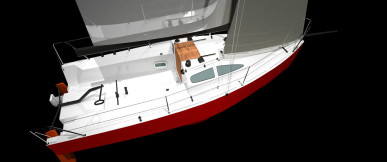
Great Projects
Build a small sailboat free plans.

These plans are for a small 15 foot knockabout sailboat.
I like these plans for their ease. Building a smaller boat is a lot more attainable than a cabin cruiser! And these plans get right to the specifics of building. From the plans:
ANY SAILBOAT fancier will like "Tramp," the trim, 15-ft. knockabout that's so easy to build in plywood. The first operation is to cut the stem, transom and side planks and assemble the forms.
Use casein or waterproof glue under the butt strap joining the side planks together. Forms can be made of almost any scrap material on hand. If you are a good enough mechanic, they can be dispensed with and correctly beveled frames made to their exact shape can be placed permanently in the boat. Screw-fasten the oak frame at sides and bottom on the inside of the transom. Then notch out the bottom of the frame to receive the keel batten...
The transom is placed last and must be beveled so that the side planks fit tightly against the cleats and the transom edge. Be sure to place white lead and a thin thread of cotton between planks and stem and transom prior to joining them together...
Related Plans

All Our Vintage Projects Categories
Vintage projects.
All rights reserved, 2020 [email protected] Copyright, Safety and Legal Information Terms of Use - Privacy Policy Site Map
Discussion Forum
Ask questions, get answers, share stories in our discussion forum!
How to Make a Small Sail/Row Boat

Introduction: How to Make a Small Sail/Row Boat

Step 1: Tools
Step 2: supplies, step 3: beginning.

Step 4: Cutting the Ribs or the Structure of the Boat

Step 5: Attaching Sides

Step 6: Bending the Wood

Step 7: Center Board Hole


Step 8: The Floor

Step 9: Attaching Rear Piece
Step 10: caulking, step 11: attaching the "deck".

Step 12: Rudder

Step 13: Mast Time

Step 14: Painting

Recommendations

Make it Resilient

Water Contest

Text Contest


- Basic Kayaking Knowledge , Learn
15 Free Boat Plans You Can Build This Week (with PDFs)
Boatbuilding is one of the most ancient forms of craftsmanship still alive today. As long as our ancestors have had a curiosity about exploring open waters, they have been practicing and honing their boatbuilding skills.
To be honest, however, building a boat is no small task. It will require a lot of work and patience to ultimately create a finished product that you are happy with and that is actually seaworthy.
Of course, we have also included a few free boat plans. You can keep in your back pocket for the next time you are asked to build a cardboard boat as part of a contest or lakefront teambuilding adventure.
We hope that these resources help you in your journey to build your own boat!
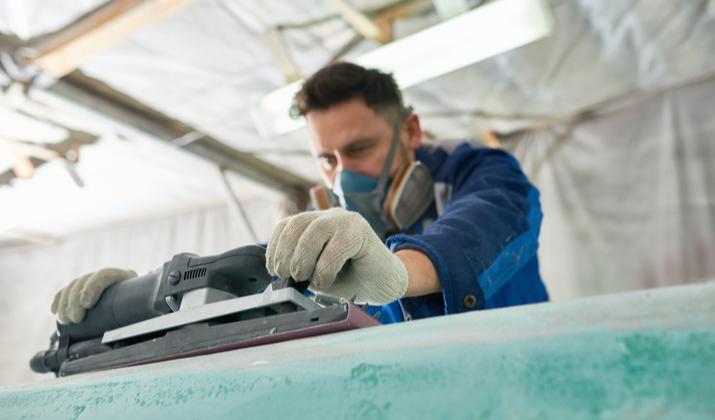
Photo by SeventyFour via Shutterstock
Free Boat Plans
- The Wanigan
- The Slipper
The Handy Andy
- The Jolly Roger
- The Hobby Kat
The White Duck
- The Sea Midge
The Crazy Cardboard Boat
Why Build Your Own Boat?
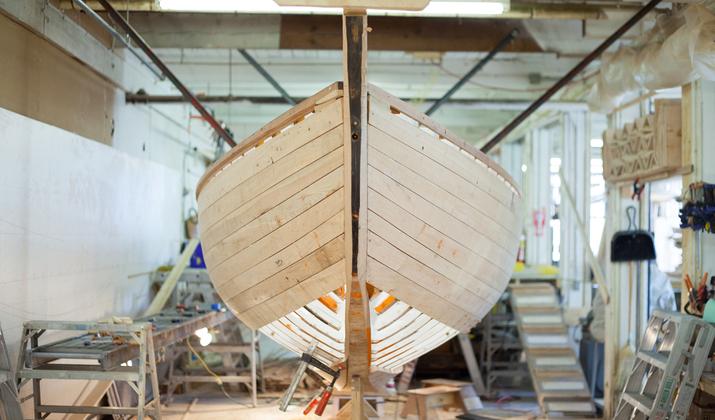
Photo by Halsey via Shutterstock
There are a lot of reasons why you should explore building your own boat versus buying a pre-made model. Here is a quick breakdown of the most obvious benefits:
- You will know the ins and outs of your finished boat better than anyone
- It can be a great project to work on with your teenage or even adult children
- You will gain valuable skills molding and shaping wood and other materials
- You can design your boat for your specific needs
- You don’t have to trust the sometimes-questionable manufacturing of mass-produced boats
- You can create a boat that functions as your second home on the water
- You can save money if you source materials mindfully
Of course, most first-time boatbuilders still experience some level of trial-and-error. With patience and perseverance, however, you can craft a one-of-a-kind vessel that has no equal anywhere in the world.
Free Boat Plans You Can Build This Week (with PDFs)
1. the wanigan.
PC Duckworks Boat Builders Supply
The Wanigan boat began as a garvey design, which is one of the older boat plans known to the Americas. Traditionally, these boats were built as work scows and were very popular among American summer camps.
The design itself is very simple, but these boats can carry heavy loads. It can also handle a trolling motor being mounted to the stern so you can cover more ground if you want to use it as a fishing boat.
The creator of this boat plan became aware of some of the downsides of the garvey design, such as the heavier weight that made it less efficient than some other designs. So he combined elements of dory and wanigan designs to create a hybrid.
The main changes include an enlarged beam, tilted lathes to provide a stiffer hull, and knocking off the top strakes to reduce the boat’s overall weight.
The Wanigan text
These additional The Wanigan drawings  may also prove useful for your build process!
2. The Mouse
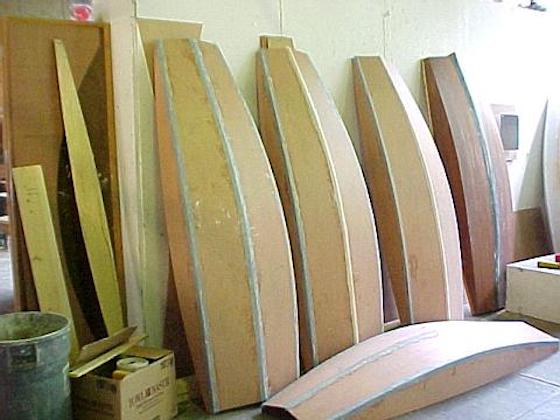
The Mouse is one of the most compact and nimble boat plans we have found for this list. It is an easy build and also a great boat for two kids or a single teenage paddler.
The original builder began with a one-sheet boat design in an effort to create the lightest and most affordable boat possible. This means it is only suited for calm waters and should not be used in high winds or wavy conditions.
That said, it was built in roughly 12 to 24 hours of work time and doesn’t require a full workshop to construct. The main material that is required for building this boat is quarter-inch plywood. But the builder recommends using one-inch by half-inch pine or something a little sturdier.
The plywood and pine components are held together using a method called ”˜stitch and glue’. This method requires choosing one of the best glues for kayak outfitting , which are typically made of epoxy and glass tape rather than something cheaper like polyurethane.
The Mouse Instructions
Also, here are a few extra useful The Mouse Notes for builders
3. The Slipper
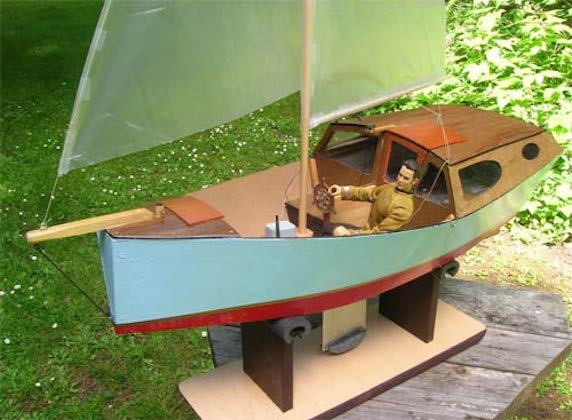
The Slipper is the first of many sailboat plans on our list and it is faster, easier, and cheaper to build than most. It also features a deeper cockpit than many other sailboat designs, which makes it safer for intermediate sailors.
This sailboat plan features dual steering stations so that you can sail from inside or outside of the helm. It also includes a centerboard trunk that hardly intrudes into the cabin at all. So that, it is easier to work around while you are in the cockpit.
The exterior hull and cabin of this sailboat feature a modified dory design using two sheets of plywood ripped to three feet wide before being joined together. The resulting hull is a modified V-shape that reduces drag.
The centerboard of this boat can also be winched up to the level of the top of the cabin or lowered down to alter the draft. This allows you to customize the boat design for a stiffer and more weather-worthy vessel if you need it.
The Slipper was also intentionally designed with an aft cabin that naturally helps to keep the bow pointed into the wind whether you are underway or the boat is anchored in the port.
The Building Slipper
4. The Handy Andy

PC DIY Wood Boat
The Handy Andy is a great little 10-foot portable rowboat for hunting, camping, fishing, and other recreational uses. It is actually the only folding boat design on our list, which makes it best for folks that need the most portable boat plan possible.
This boat features a 42-inch beam and a depth of about 15 inches at the mid-section. It also weighs roughly 80 pounds when assembled and can handle up to three average-sized human passengers.
The design boasts a flat bottom with canvas-bound edges and the primary material used for construction is ⅜-inch marine-grade plywood. Despite its lightweight nature, this rowboat can handle trolling motors or even outboard motors with a maximum of five horsepower.
Once finished, the hull can be folded or unfolded in less than a minute’s time.
This design makes it one of the only boats on this list that can be stored in a truck bed or easily carried by two people to be launched at more remote locations.
5. The Junior

If you are looking for an all-purpose dinghy that can handle almost any use you might imagine, look no further than The Junior free boat plan. It can carry three or four average-sized adults and is much easier to row than a traditional dinghy.
It is also durable enough to be equipped with a small outboard motor. You could even set it up with sailing equipment if you want to use it as a sailing vessel. As we said, this is truly an all-around boat design!
This boat plan requires constructing three frames that will provide the majority of the load-bearing support. The builder recommends using ¾-inch framing with ⅜-inch plywood as the exterior material for this boat build.
Resin glue and flathead screws are also required to hold this boat together. But there is a full list of materials included in the plans we have linked to below. Sticking to that plan should also give you enough leftover materials to construct two six-foot oars for rowing this boat until you install a trolling motor or outboard motor down the line!
6. The Jolly Roger

Channel your inner Captain Morgan when you are following these plans to build your very own Jolly Roger boat. This flat bottom boat design is designed for pond fishing . It can also be a useful yacht dinghy for getting from your dock to a larger vessel anchored offshore.
The plan follows conventional dinghy construction methods but also includes a few modifications that will save you time and energy. The wide design is super stable for boaters of all ages.
The keel, frame, chines, and risers are all cut from ¾-inch oak, ash, or any other trusted hardwood you can get your hands on. For the smaller components, the builder recommends using cedar, cypress, fir, or white or yellow pine.
Because this boat plan is also sturdy enough to handle a small motor, it includes important points for protecting the wooden hull from spark plug damage.
Be careful to follow these guidelines to build the safest boat possible if you imagine installing a motor down the line.
The Jollyroger
7. The Cork

The Cork is another simple rowboat design. This one trends away from the flat bottom plans that we have included thus far. Instead, it features a deeper, V-shaped hull that makes it better suited to more efficient rowing and easier maneuverability.
It can be rowed easily from either seating position and is durable enough to handle up to three average-sized adult passengers. The ends of the boat are identical, which allows for multi-directional rowing.
The list of materials required for this boat plan should cost you between $30 and $50, depending on your location and hardware costs there. The resulting build is lightweight enough for two people to be carried and also to be transported on top of a vehicle .
Inside the boat, the builders use aluminum tubing to secure the struts that hold the seats. This material choice keeps the overall weight of the boat down while still adding the necessary rigidity across the beam of the boat.
8. The Hobby Kat

The Hobie Cat is one of the most iconic and recognizable small sailing vessels ever made. This Hobby Kat plan is your answer to building your own iconic sailboat without spending thousands of dollars.
Your finished boat will be able to handle speeds of up to 20 miles per hour. It will be a super fun vessel for windy days on the lake or bay. The builder was able to construct the hulls, decking, and rudder for this boat while spending little more than $200.
From there, they purchased and installed the mast, boom, sail, and rigging, which brought the total amount spent to roughly $650 (still much less than a name-brand Hobie!). Without the mast and sail, this boat weighs roughly 165 pounds and is constructed using primarily 3/16-inch marine plywood.
You can also elect to build your own mast, boom, and sail if you have the time and skills to do so.
Those elements are not included in this boat plan, but they do offer some recommendations for where to buy these components!
The HobbyKat
9. The Tern

Named after the common seabird found around the world, the Tern is a lightweight and nimble sailboat with a 72 square foot base design. She is made for inland sailing and planes very well in moderate breezes.
The hull design also provides minimal water resistance and the small floor plan makes this boat easier for intermediate sailors to handle. Even though it offers a small footprint, this boat is sturdy enough to handle up to four adult passengers.
One of the best things about this boat plan is that it can be built almost entirely by using only common hand tools.
Of course, you can speed things up if you have power tools and you are skilled enough to use them correctly.
The Tern boat plan includes a 20-foot mast, but you can shorten that length if you desire. The plan includes a complete list of materials and step-by-step instructions on how to plane and assemble each element.
10. The Falcon

As you might expect from its name alone, the Falcon is an incredibly speedy sailboat for its size. It boasts a 14-foot centerboard and can handle two to four passengers, depending on its size and weight.
In tests of the original build, the creators claim that this boat out-distanced many Snipe and Comet sailing vessels as well as pacing evenly alongside longer 18-foot sailboats. When finished, your boat will have a six-foot beam and a total weight of roughly 475 pounds.
For the main framing components, they recommend using white oak and plywood will be the main material used in the hull construction. The hull features a V-shaped that was inspired by larger schooners.
The Falcon is best suited to sailing on bays, lakes, and wide rivers. It is also a boat plan with just under 120 square feet of deck space and it is a great build for amateur craftsmen and sailors.
11. The White Duck

The White Duck is a flat-bottomed rowboat with a total length of 13’6” and a four-foot beam. The cockpit is approximately 15 inches deep all the way around and this boat can handle up to five passengers while maintaining buoyancy and stability.
When fully constructed, it will weigh roughly 200 pounds, but the final weight will depend on the type of lumber you choose for your build. This boat plan features plywood planking over solid wooden frames.
The White Duck is built with a pointed bow that cuts nicely through the water. The flat stern of this boat design will make it easy to attach a small outboard motor with a maximum of six horsepower.
As you might expect from its name, this rowboat is a great option for duck hunting trips. That being said, it is a highly versatile craft that can also be used for pond fishing or casual rowing on your nearby lake.
12. The Sea Midge

The Sea Midge is one of the smallest rowboats on our list and it is ideally suited for one average-sized rower or two small paddlers. It is only about 8 feet in length and offers a 52-inch beam at its widest point.
The Midge’s small dimensions make her ideal for navigating narrower creeks and streams. With an approximate weight of 62 pounds, she is easy to maneuver on the water and can also be much more easily transported than some of the larger boat plans on our list
The Seamidge
13. The Zephyr

The Zephyr is a compact and speedy dinghy sailboat that measures roughly 14 feet long and approximately five feet across. This boat style was originally developed for safely crossing the English Channel. This means it can stand up well in rough waters.
When finished, it is also light enough to be transported on a small trailer or on top of a larger vehicle.
The boat plan calls for using hemlock or fir for the framing and oak or Douglas fir for the keel and chines.
14. The Gypsy

The Gypsy is a small cruising sailboat that is meant to be equipped with an outboard motor for powered locomotion. The original design resulted in an incredibly seaworthy vessel that logged more than 6,000 nautical miles in her lifetime.
It includes a comfortable cabin that makes it well-suited for multi-day sailing adventures. This boat plan includes improvements on the original design that will help you build an extremely durable and long-lasting sailboat.
The Gypsy boat design will help you construct a vessel that can handle a motor up to 25 horsepower so that you can enjoy cruising speeds of up to nine miles per hour.
While it may require a bit more of an investment in time and money, it will also help you produce one of the best boats you can build with a free boat plan!
15. The Crazy Cardboard Boat

PC Saint Dominic Catholic School
Finally, let’s talk about a crazy cardboard boat plan that you can build in less than a day. This is a great boat plan to bookmark for your next teambuilding project so that you can earn bragging rights with your coworkers.
The plan calls for using 1.5 sheets of cardboard. But you can use the remaining half sheet to build your own boat paddle if you want to get creative.
Triple-thick cardboard is best for this boat plan. But you can always double up thinner sheets if that is all you can find.
These plans include an easy-to-follow diagram for marking, cutting, and folding the cardboard sheets to create the hull of your boat. From there, it calls for using contact cement and construction adhesive to seal the edges and corners.
If you are looking to save a little money on this build you could also use duct tape and then wrap the entire design in plastic sheeting to provide waterproof qualities.
Overall, this build is one of the cheapest and easiest on our list. It is also a great project for hot summer camp days on the lake or river!
15 Free Boat Plans You Can Build This Week (with PDFs) – Final Thoughts
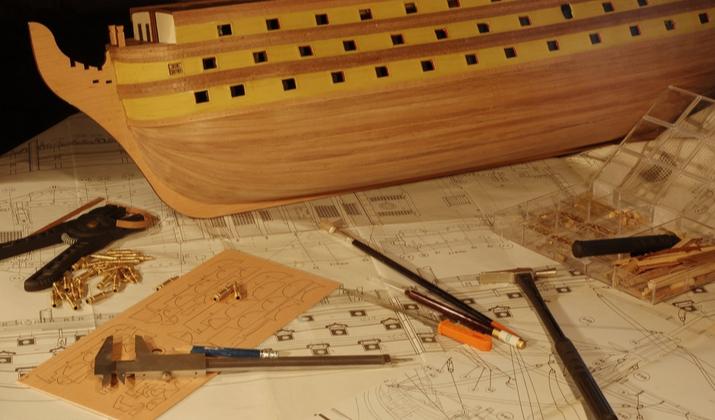
Photo by Alexandra Soloviova via Shutterstock
We hope that you now have a couple of free boat plans to inspire you to begin your own construction project.
Don’t hesitate to check out YouTube for some useful boat-building videos when you are getting into the nitty-gritty of these build processes!
Enjoyed 15 Free Boat Plans You Can Build This Week (with PDFs)? Share it with your friends so they too can follow the Kayakhelp journey.
Share on pinterest.
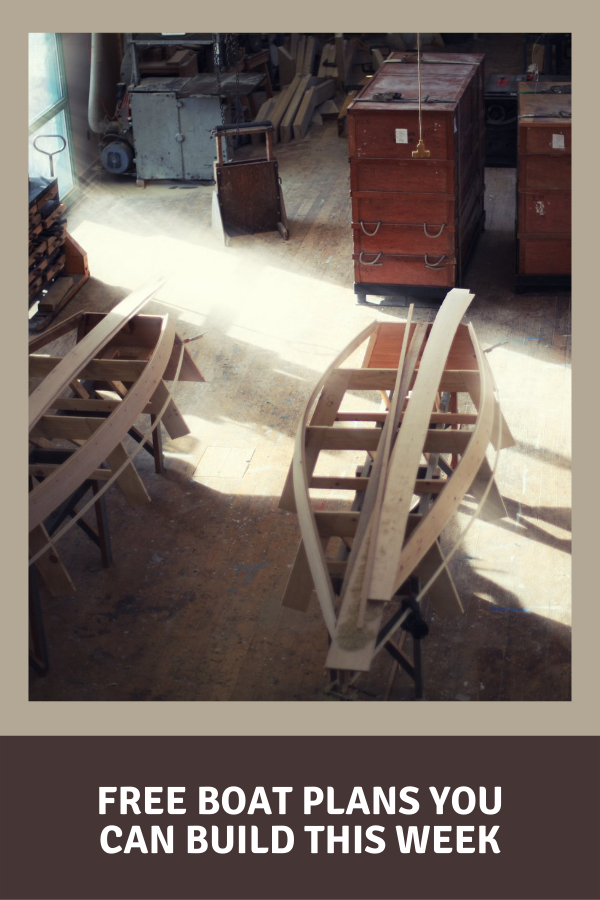
Peter Salisbury
Pete is the Owner of KayakHelp.com. Born and raised in Cleveland, Ohio, he grew up kayaking, fishing, sailing, and partaking in outdoor adventures around the Great Lakes. When he’s not out on the water, you can find him skiing in the mountains, reading his favorite books, and spending time with his family.

- Activities for Kids
- Arts & Crafts
How to Build & Float Your Own Mini Sailboat

Crafting and outdoor exploration come together with this project—learn how to build a boat that floats and sails. The best part? You’ll only need to buy a couple of supplies because the main part of this barge is made from sticks that you find outside. Read on for the step-by-step instructions and you’ll soon have a ship to sail the high seas (or slow streams).
What You’ll Need
1 piece of paper (patterned scrapbook paper is nice, but plain construction paper also works)
2 craft sticks
string or twine
hot glue gun
14 sticks in similar sizes (5-6 inches long works well)
How to Make the Boat
1. Start by wrapping 12 the sticks together with your twine. We used Kid Made Modern Craft Twine ( target.com , $9.99) to add a pop of color, but white string would also work just fine. Tie one end of the twine to the end of one stick and wrap the string around a few more times, then move on to the next stick. Wrap the twine around that stick a few times and then use the same piece of twine to wrap the third stick and so on and so on until 12 of your sticks are connected. (You’ll use two elsewhere.) Don’t worry too much about how many times you loop around or how perfect your wrapping is. Knot off the twine on the last stick. Then, do the same thing on the opposite side of your sticks.
2. Wrap two sticks onto the bottom. Now add two more sticks, one on each end of your boat, to the bottom of your group of sticks. Again, tie a knot on one end of the stick then weave your twine in and out of the connected sticks, looping the twine around each stick and then around the stick on the bottom. Repeat for the second stick.
3. Cut 2 triangles out of your paper. Ours measured 5-inches along the side and bottom, but you may want to adjust based on the length of your sticks. We used Kid Made Modern Print Palooza patterned paper ( target.com , $7.99 for 150 sheets). However, if you have plain construction paper, ask your child to decorate it with stickers, crayons, markers, or any other way you like.
4. Add the craft sticks as your mast. Line up the craft sticks along the edge of the triangle to create your mast. Use a hot glue to secure the craft sticks.
5. Glue the triangles together. Ask your child to cover the two triangles with glue, using the glue stick. Then, press them together to complete your sail.
6. Connect the sail to the raft. Slip the craft stick in between two of the sticks in the middle of your boat. Use a piece of twine to wrap around the craft stick and around the two middle sticks until it feels fairly secure. To give it extra support, add hot glue all around the area where the craft stick and twigs come together.
7. Sail your boat. Once the glue has cooled and dried, your craft is ready for its first voyage. Fill a baby pool or other vessel (even the bath tub!) with water and watch your homemade schooner float.
8. Create some wind. Want to get your boat moving faster? Use a straw to blow it across the water.
9. Take it to the park. For further experimentation, we took our model to the park so it could sail in a real stream. Even after several sails and a few capsizes, our sailboat has held up.
Happy sailing!
Project inspired by Minieco’s handmade boats .
Have you crafted any boats with your kid? Tell us about your design in a comment.
–Julie Seguss
Need some fresh ideas?
Subscribe to our weekly newsletter for expert parenting tips and simple solutions that make life instantly better.
By subscribing you agree to Tinybeans Terms and Privacy Policy
Related reads

Why Are Gen Z Kids Covering Their Noses in Family Photos?

Screen Time for Babies Linked to Sensory Differences in Toddlerhood, Study Shows

Kids Shouldn’t Have to Finish Dinner to Get Dessert, Dietitian Explains

The Questions Parents Should Be Asking Their Pediatrician—but Aren’t

6 Better Phrases to Say Instead of ‘Be Careful’ When Kids Are Taking Risks
- your daily dose

- and connection

- Your daily dose

- PRO Courses Guides New Tech Help Pro Expert Videos About wikiHow Pro Upgrade Sign In
- EDIT Edit this Article
- EXPLORE Tech Help Pro About Us Random Article Quizzes Request a New Article Community Dashboard This Or That Game Popular Categories Arts and Entertainment Artwork Books Movies Computers and Electronics Computers Phone Skills Technology Hacks Health Men's Health Mental Health Women's Health Relationships Dating Love Relationship Issues Hobbies and Crafts Crafts Drawing Games Education & Communication Communication Skills Personal Development Studying Personal Care and Style Fashion Hair Care Personal Hygiene Youth Personal Care School Stuff Dating All Categories Arts and Entertainment Finance and Business Home and Garden Relationship Quizzes Cars & Other Vehicles Food and Entertaining Personal Care and Style Sports and Fitness Computers and Electronics Health Pets and Animals Travel Education & Communication Hobbies and Crafts Philosophy and Religion Work World Family Life Holidays and Traditions Relationships Youth
- Browse Articles
- Learn Something New
- Quizzes Hot
- This Or That Game
- Train Your Brain
- Explore More
- Support wikiHow
- About wikiHow
- Log in / Sign up
- Hobbies and Crafts
- Woodworking
- Wooden Sports Equipment
How to Build a Boat
Last Updated: January 21, 2024 Approved
wikiHow is a “wiki,” similar to Wikipedia, which means that many of our articles are co-written by multiple authors. To create this article, 45 people, some anonymous, worked to edit and improve it over time. wikiHow marks an article as reader-approved once it receives enough positive feedback. In this case, several readers have written to tell us that this article was helpful to them, earning it our reader-approved status. This article has been viewed 291,645 times. Learn more...
Little boats are perfect for trips around the lake. They fit on the roof of your car and in the back of truck beds, making them perfect for spontaneous camping trips. This article describes a method for building a canoe, (12'x30", with 11" depth), using a stitch and glue style of boat building.
Building the Frame

- A long stick or batten is used to draw a line between these points giving the outlines of the canoe's panels. Make sure the lines drawn for the panels are all fair, smooth curves.
- Only three panels are needed per side. The four half sheets of 8' plywood are used to make 12 boat panels, then these 12 panels are put together in matching pairs with butt blocks or scarf joints to make up the total 6 panels or 3 per side.
- Finger joints, using a dovetail template and a router will also make good joints to join the panels. You have to allow for the 1" overlap of each panel when making the finger joint, as this gives the boat an attractive finished look.
- This system makes a simple but very nice boat and has a recognizable canoe look and shape with a gentle "v" bottom, rather than a flat bottom.

- Once you have cut the panels out, use a woodworkers rasp (file) to smooth up the edges as close to the lines on the panel as possible. A small block plane could be used instead.
- Now you can put the panel pieces together as stated above with finger joints, scarves or butt blocks. More specific instructions on how to do each of these joints is easily available online.

- This job is easier and faster if you lay the two matching panels (the corresponding panels on either side) together and drill the holes.
- This boat has only three panels per side, with each of the three being the same on either side of the canoe.

- Lay the two bottom panels on top of each other and wire the center/bottom edges together, but don't pull the wire too tight. Leave the wire loose, so you can open the bottom two panels up like a book. This will be the bottom of your canoe.
- Now, starting in the center, wire (stitch) on the next panel, putting a few stitches on each side of the center line. Keep working from side to side doing a few on each side until you get to the ends.
- When you get to the upper panels, line up the ends and stitch them together. Try to keep them as even as possible, with a nice canoe end curve. You should begin to see the canoe coming together at this point. [2] X Research source

- Is it fair, with nice flowing lines and no twist? If not tighten or loosen the wire stitches as necessary, or even add a stitch if needed. Make sure it looks pleasing to the eye.
- Check to see if there is any twist in the canoe, using winding sticks. Make sure the panel edges are all sitting on top of each other nice and tight and not overlapping at any point.
- You can also do a trick called cutting a transition joint, which is a 1/4 or 3/8" notch cut 24-36" (depending on the width of the panel and length of the canoe) into the bottom front edge of the top panels. This gives you a nice smooth side. More detailed instructions on how to do a transition joint can be found in many books covering stitch and glue boat building or on the internet.
- Finally, be sure that the panels are not pushed out from each other at any one point, you want nice, smooth-stitched seams.
Bonding the Panels

- Try to cover each edge about an inch on either side of the joint, making sure that it soaks into the joint to get a good bond. Make it look like you're painting a strip down the joint. Remember that the joints of the panels and stems only get epoxied on the inside for now.
- Repeat this process for each of the joints. Try not to let the epoxy run down the sides of the panels -- you only want it on the joint, no runs. If you have any runs, use another brush to wipe them up. This just makes life easier when it comes to sanding the inside of the boat. Remember to check the outside of the seams for runs as well.
- Put two coats of epoxy on the joints and stems (stems are the ends of the boat), letting the epoxy dry before re-coating. Be sure the stems are pulled tightly together (using the stitches) before applying the epoxy. Don't use clamps to pull the stems ends together, stitches only!
- Each coat of epoxy needs about 24 hours to dry, so try to have a little patience while dreaming of that smooth glassy lake!

- Do this with care, as the panels' joints are still fragile at this point. Try not to break the epoxy join, and don't leave any wire in the boat.
- If you pull out a wire and the joint opens, put a stitch back in and epoxy that joint area again.

- Mix the wood flour and epoxy to a smooth creamy mixture -- it shouldn't be runny. Apply this fillet to the joints that you put the epoxy on.
- Make a nice smooth bead about 1-1/2-2" wide over the center of each joint, then apply a smooth bead of fillet to the inside of the stem ends.
- Make the stem end fillets about 3/4" thick on the inside -- although this adds weight, it has the benefit of making the stem nice and strong.
- However, you should be careful not to add too much epoxy, as it can become brittle.

- Apply another coat of epoxy, smoothing it over the fiberglass until it turns clear. To make the joint as smooth as possible, add just enough epoxy to turn the fiberglass clear, then use a squeegee to remove any excess. Remember that applying too much epoxy is as bad as applying too little.
- Be gentle while doing this, as you don't want to push the fresh fillet mix out of the joint when you push down on the fiberglass with the squeegee.
- When you get to the stems, add a 3" wide strip of fiberglass to the inside of the stems (over the fillet). Allow the stem end fiberglass to come down over the center strip of fiberglass tape, as this will make one complete, strong joint.
- You will need to add a second coat of epoxy to these tapes after the first coat cures, again waiting 24 hours between each coat.

- Now use a fine rasp (woodworkers file) to smooth over the edges of the bottom and lower panel joints, being careful not to splinter the thin plywood. Then use sandpaper (80 grit) to smooth up the joint edge, being careful not to sand too deep into the plywood.
- Sand the entire outside of the boat, using a 120 grit sandpaper. Make sure to clean up any drips and runs from the epoxy that ran through the joints. Remember to sand with care - don't sand into the thin layers of the 1/8' plywood as this takes away from the canoe's outer skin and leaves hollow flat spots.
- When the sanding is done wipe off the excess dust using a cheesecloth, then use compressed air and a clean cloth to remove the more stubborn dust. Sweep the floor, and wait until the dust has settled before proceeding.

- Lightly sand the epoxy-coated outside of the boat with 120 grit paper. This is only necessary to provide a tooth for the next coat of epoxy and fiberglass to hold to.
- Now it's time to add fiberglass cloth to the outside of the boat. The fiberglass can weigh anywhere between 4 oz and 8oz, depending on the intended use of the canoe. The larger the fiberglass the heavier the canoe will be as the heavier fiberglass requires more epoxy.
- Use the same technique of applying the fiberglass to the outside of the boat, then applying a layer of epoxy on top. If you have never done this before, it's a good idea to read as much as you can about it first. Being informed will help you do a really nice job on the boat.

- If you wait until the epoxy hardens, it will be very hard to trim the excess fiberglass cloth from the edges of the canoe.
- To trim the fiberglass cloth, use a razor knife and trim off the cloth along the gunnel's edges. Be gentle while trimming -- try not to pull on the cloth as it is still wet and it will move and cause you problems.

- Be aware that it might take more than two coats to fill the weave of the cloth depending on the type and weight of the cloth.
- With the fiberglass on and trimmed, give the outside a light sanding with 220 grit sandpaper, then clean off all dust. You can now clear coat or paint the boat.
Finishing the Job

- Gunnels give a completed look to the canoe, while also serving to protect the sides of the canoe as rub rails.
- Each gunnel should be about 1-1-1/4"x3/8-1/2" square, with the top outside and inside edges rounded over. Use epoxy and brass or bronze screws to attach the gunnels at the front 24-30" of the gunnels. You can use the epoxy and spring clamps to attach the gunnels to the canoe until the epoxy dries.
- At the stem ends on top of the canoe you can fit small decks, on top of the rails or between them, if you take the time and effort to make a good fit. Flush decks look the best.

- When all the sanding is done, it's time to coat the inside of the boat with. For best results, do this in two or three thin layers of epoxy, waiting 24 hours between coats.
- When this is all done you can sand the last coat lightly with a 120 grit sandpaper and then a 220 grit to get a really smooth finish.
- Wipe away any dust, then paint or varnish the inside.

- All seats should be about 1-1-1/2" from the bottom of the canoe, not hanging from the gunnels.
- On a light canoe (such as this one) with a low freeboard, it's best to keep the center of gravity as low in the boat as possible.

Community Q&A
- Read all you can find about stitch and glue boat building. The more you know the less problems you'll have and the happier you'll be. Thanks Helpful 1 Not Helpful 1
- Don't get into a hurry, this is very hard to control, but an issue you must work on. Thanks Helpful 1 Not Helpful 0
- Only use epoxy plenty fresh air (ventilation) when boat building to avoid possible permanent nerve damage caused by inhaling fumes. Thanks Helpful 1 Not Helpful 0

- A wooden boat won't sink; it may swamp, but will still float, so if you fall out and the boat fills with water, stay with it, it could save your life. Thanks Helpful 34 Not Helpful 9
- Keep the area you work in clean, well vented and a fire extinguisher on hand all the time. Thanks Helpful 21 Not Helpful 11
- Epoxy is toxic and you can get very sick from prolonged exposure to epoxy. Try not to breath the fumes or let the epoxy (or its components) come in contact with your skin. Use safety gear, safety glass' prevent splatter into your eyes, an air filter (charcoal) and lots of ventilation are recommended, rubber or vinyl gloves, and an old long sleeve shirt. Thanks Helpful 2 Not Helpful 1
- Always use Personal Flotation Devices (PFDs) when you are in a boat. Do not sit on your PFDs. Certain states and local laws specifically require PFDs for young people. Thanks Helpful 2 Not Helpful 2
You Might Also Like

- ↑ https://www.christinedemerchant.com/stitch-and-glue-boatbuilding.html
- ↑ https://www.epoxyworks.com/index.php/bonding-with-fillets/
- ↑ https://www.youtube.com/watch?v=_tkR9hMq2wY
About This Article
To build a simple boat, lay the keel of the boat and then add ribs to form the shape of the boat. The ribs should taper to a point at the bow of most boats, curve outward in the middle, and narrow at the stern. To build the hull, you’ll want to use either strips of wood or sheets of fiberglass. Then, once you’ve completed the hull, paint the boat with special marine paint that won’t come off in the water. For more detailed instructions, read on! Did this summary help you? Yes No
- Send fan mail to authors
Reader Success Stories
Alan Houghey
Nov 18, 2021
Did this article help you?

Kobus Van Baalen
Dec 28, 2017
Joseph Slivinsky
Jan 14, 2018
Halt O'Carrick
May 8, 2017
Ayaan Gupta
Nov 2, 2018

Featured Articles

Trending Articles

Watch Articles

- Terms of Use
- Privacy Policy
- Do Not Sell or Share My Info
- Not Selling Info
Don’t miss out! Sign up for
wikiHow’s newsletter

How To Sail a Small Sailboat

Last Updated by
Jacob Collier
August 30, 2022
Sailing is a skill that takes time and practice to learn and perfect. Learning how to sail a small sailboat requires onshore and offshore activities.
Sailing heavily depends on the wind, and setting the sails right is a crucial sailing element. If you do not adjust the sails according to the wind, your boat will not move and, in worst cases, may even capsize.
Sailing is a skill that gets better with practice. There are several factors that you need to understand when sailing. These include the wind direction, how to turn and steer the boat, adjusting the sails, and finally, how to slow down and come to a stop.
Many novice sailors find handling the sailboat a daunting task. You have to take care of so many controls, including the tiller, the sails, and the centerboard.
Experienced sailors believe that new sailors should avoid taking their sailboats into open waters until they have gotten the hang of the water and the sailboat. Sailboats have tall sails, which make them prone to capsizing. Inexperienced sailors should either take courses on sailing or learn by going out with a friend before they head on their solo adventures.
Table of contents
How To Sail a Small Sailboat
Before heading out on your next boating adventure, you need to consider several factors. As the wind powers your boat, the first thing you need to understand is how wind strength and direction affect your boat. You will also need to learn how to handle the tiller. If you have been driving any road vehicle, you may not be surprised to see a vast difference between how a car and a boat handle.
Understanding Wind Direction
Wind plays a crucial role in how fast and the direction in which your sailboat will move. It is impossible to sail into a headwind. But you can sail around 45 degrees to headwind.
- When sailing 45 degrees to the oncoming wind, this is known in sailor jargon as the boat is close-hauled.
- When you are sailing with the wind coming from either side or almost 90 degrees to the boat, it is known for the boat to be on a beam reach.
- When you are sailing at a wide-angle in the direction of the wind. For instance, say that you need to head north, and the wind is coming from North East, the boat is called to be on a broad reach.
- If you are lucky and have the wind in the direction you are heading, your boat is known to be running.
Positioning Your Boat
It is crucial to be aware of the position of your sailboat in relation to the wind direction. This allows you to adjust the sails and balance the weight in your boat. For beginners, you can tie small wind vanes, which can be simple yarn strands on the boat to let you know where the wind is coming from.
What Affects Wind Direction
As you sail through the wind, your boat will also alter the wind direction. Since the boat has a giant sail, it creates its own wind as the boat moves forward. This wind is known as apparent wind. For instance, your boat is moving on a beam reach, where the true wind is coming from the side of the boat.
As you move through the wind, your boat makes its own apparent wind. The true and apparent winds combine, causing the wind direction to change. This can lead your boat to be on a close haul rather than on a beam reach. What matters, in the end, is how much resulting wind there is in your sails and the direction it is coming from.
Getting Ready To Sail
The best method to start sailing is to take the boat on from a point such as an anchor line or a mooring buoy. The wind will push the boat backward and out into the open waters as you get into the boat and set the sails up.
Moving stern first is acceptable when being pushed out of the marina, but this is not the direction in which we will want to continue sailing. You will have to turn the boat around so that wind is pushing the boat bow first.
Turning To Set Direction
As you come out of the marina, you will need to adjust your sails to change direction. Remember, boats require time to respond and need patience above all else.
The first step is to push the boom out of both sides of the boat. This will cause the wind to blow against the sail's back and not past its sides, causing the boat to rotate. As you pull in the sail and set its direction, the boat will begin to correct its course. Once you are in the right direction, you can tighten the mainsail and be well on your way.
Starting From A Beach Or A Dock
Starting from a beach or an enclosed dock can be quite challenging. If the wind pushes the boat sideways into the dock, it is next to impossible to sail out of the dock. In such a scenario, it would be best if you could walk your boat like a pet to the dock's end and attempt to turn it around to face the wind. You can then follow the procedure described above to allow the boat to come out of the marina.
Your boat will not move if the sails are not taut. As soon as you tighten the sails, the wind will move the boat, and you can then set the direction to your preference.
Steering The Boat
Now that you have set the direction and are moving in the correct direction, you will need to maintain direction and be able to steer the boat through the water. Before you begin to steer the sailboat, you must ensure that you are sitting in the direction opposite the sail. This is usually the direction from which the wind is blowing.
When the wind blows against the sails, it can cause your boat to tilt in their direction. Your body weight will counter the tilting effect and keep the boat level.
Using The Tiller
The sailboat is equipped with a rudder. As your boat picks up speed, you can use the rudder to steer the boat. A little tiller usually controls the rudder. The tiller takes some time to get used to. The reason for this is that it works in opposite directions. For instance, if you want to make the boat turn right (towards the starboard side), you will have to push the tiller to the left (towards the port side) and vice versa.
The rudder is hinged in line with the tiller. When you move the tiller in one direction, it moves the rudder. For instance, the rudder will extend towards the starboard side if you push the tiller to the port side. The water flowing will push against the rudder, and the resistance from the rudder will rotate the boat towards the starboard side .
The tiller can be tricky to use. Ensure that you make minor adjustments to the tiller until you get used to how it moves your boat.
Handling The Sails
There is one rule that you must remember when positioning your sails. If you are sailing towards the wind, you will have to pull in the sails more. Similarly, if you are on a broad reach and sailing in the direction of the wind, you will have to extend the sails more.
When the sails are extended and you are on a broad reach, you will notice that the boat tilts to the side the sails are on. You must seat yourself so that you counter the tilting effect.
Sail Trimming
No, you don't need a pair of scissors for this. A sail comprises multiple sheets, and adjusting these sheets is known as trimming the sail. Your goal with trimming the sail is to give the sail the best possible shape to make maximum use of the wind.
Mainsail Trimming
When trimming the mainsail, you will have to make sure that it is tight enough so that the sail's leading edge is not flapping or shaking. At the same time, you have to ensure that it is not too tight, causing the wind to blow against only one side of the sail. This can cause the boat to tilt to one side.
Leaving the edge loose means you will lose efficiency. The wind energy will be used to flap the sail instead of pushing your boat forward. This unwarranted movement of the sail is known as luffing, which can significantly reduce the boat's efficiency.
Adjusting The Mainsheet
One method to trim the mainsail is to let the mainsheet out until the mainsail starts to luff. Then slowly pull in the sheet, and stop as soon as the sail stops luffing.
If the sail is too tight, you will be able to judge by its appearance. The sail will have no slack and will look perfect. The only way to correct the tightness is to loosen it until it starts to luff, then tighten it gradually, and stop as soon as the luff is gone.
Trimming The Jib
Adjusting the jib also follows the same procedure as the sail. The goal is to loosen the sail until it starts to luff and then tighten it back up until there is no luffing. Like the mainsail, the appearance of the job will have a lot to say about its tightness.
Some sailboats have streamers on the leading edge of the jib, which depict airflow direction over it. When the sail is in the correct trim setting, the streamers will blow straight and on both sides around the sail.
Another factor to consider when adjusting the jib is the space between the mainsail and the jib. The gap, known as the slot, has to be the same from front and back. This ensures that wind flows smoothly between the sails, making the setup efficient. If either is too tight or loose, the slot will obstruct the wind flow, causing turbulence and slowing the boat down.
Turning The Boat
The most crucial part of sailing is always being aware of the wind direction. This becomes even more important when you are planning to turn the boat. If you are careless while making the turn and accidentally turn the wrong way, you may capsize the boat .
There are three common types of turns that you can make with sailboats.
Sailing Close Hauled
If the wind is coming at you head-on from either side, and you are close hauled, check for the direction of the wind. If it is blowing from the starboard side, turn the boat towards the right so that you point your bow into the wind. Continue turning until the wind is now coming to your port side. This technique is called tacking, which involves turning into the wind.
Sailing Broad Reach
If the wind is coming from either side or slightly behind you, you can turn so that the stern of your boat becomes head-on with the wind. For instance, if the wind is coming from the starboard side, you will turn left to make sure the wind hits the stern. This technique is known as jibing, and it allows you to make the turn downwind.
No Wind Crossing
This technique can be used if you want to make small turns. Say you are sailing close-hauled with wind flowing from your port side. You turn left, and now the wind is approaching from the side, and you begin to sail broad reach. The wind remains on your starboard side, but the direction has changed.
How To Position The Sails
For the initial two types of turns, where you will be crossing the wind with your stern or bow, the sails will have to be crossed over to the opposing side. You will also need to change your seating location to make sure you sit opposite the sails.
Since crossing the wind requires a lot of work, most sailors prefer to turn without crossing the wind. All you need to do is make small trimmings to the sail to keep you going in the right direction for this type of turn. With experience, you will be able to adjust the sails during your turn.
Remember, the closer the wind direction is to your bow, the more you will need to pull in the sails. The closer the wind direction is to your stern, the more you want your sails to be open. While turning, it would be best to keep one hand on the mainsail if you need to adjust its direction to prevent your boat from being blown in random directions.
The Centerboard
You will notice a thin and long blade of metal or fiberglass hanging from the boat's center and into the water. This component is called the centerboard, and it helps resist the sideways movement of the boat. You can raise or lower the centerboard at your discretion.
When you are sailing, the wind comes from either the left or right of the boat. If the wind is strong enough, it can push the boat to one side. Lowering the centerboard will cause it to act as a keel and prevent the boat from veering off in the wind direction.
When you are sailing along with the wind, you will have the wind coming from the rear of the boat, and it will have little influence from either side. In such a scenario, you will not need the centerboard. Raising the centerboard will reduce the drag, allowing you to sail faster.
As a beginner, it is recommended to keep the centerboard down. Who knows when it may save you? You don't have to be too concerned about it, as you have more important things such as the sail to worry about.
Slowing Down and Stopping
When it comes to sailing, speed is thrilling. Going fast is fun, but in a sailboat, speed is an achievement. The only thing more important than going fast is knowing how to slow down, such as when coming to a stop or avoiding an obstacle along the way.
Theoretically, to slow down, you have to do the opposite of what you would do if you wanted to speed up. This means that you will want to ensure that any wind that falls on your sails gets wasted or "spilled."
The best way to do this is to let out and loosen the sails until they begin to luff. If you need to slow down faster, you can loosen them further until they start to flap. If you plan to come to a stop, you can let the sails flap continuously.
However, if you are heading downwind or running, the mainsail should not be pushed out. Instead, you can pull it in as much as possible so the sail will not collect any wind. With no wind in the sails, your boat will slow down.
The simplest way to stop the boat is to turn it towards the wind. This will ensure maximum resistance and bring the boat to a halt.
Related Articles
What Are Small Sailboats Called?
10 Best Small Sailboats (Under 20 Feet)
Are Small Sailboats or Big Sailboats Faster?
Born into a family of sailing enthusiasts, words like “ballast” and “jibing” were often a part of dinner conversations. These days Jacob sails a Hallberg-Rassy 44, having covered almost 6000 NM. While he’s made several voyages, his favorite one is the trip from California to Hawaii as it was his first fully independent voyage.
by this author
How to Sail
Most Recent

What Does "Sailing By The Lee" Mean?
Daniel Wade
October 3, 2023

The Best Sailing Schools And Programs: Reviews & Ratings
September 26, 2023
Important Legal Info
Lifeofsailing.com is a participant in the Amazon Services LLC Associates Program, an affiliate advertising program designed to provide a means for sites to earn advertising fees by advertising and linking to Amazon. This site also participates in other affiliate programs and is compensated for referring traffic and business to these companies.
Similar Posts

How To Choose The Right Sailing Instructor
August 16, 2023

How To Sail From California To Tahiti
July 4, 2023

How To Tow A Skier Behind A Boat
May 24, 2023
Popular Posts

Best Liveaboard Catamaran Sailboats
December 28, 2023

Can a Novice Sail Around the World?
Elizabeth O'Malley
June 15, 2022

4 Best Electric Outboard Motors

How Long Did It Take The Vikings To Sail To England?

10 Best Sailboat Brands (And Why)
December 20, 2023

7 Best Places To Liveaboard A Sailboat
Get the best sailing content.
Top Rated Posts
Lifeofsailing.com is a participant in the Amazon Services LLC Associates Program, an affiliate advertising program designed to provide a means for sites to earn advertising fees by advertising and linking to Amazon. This site also participates in other affiliate programs and is compensated for referring traffic and business to these companies. (866) 342-SAIL
© 2024 Life of Sailing Email: [email protected] Address: 11816 Inwood Rd #3024 Dallas, TX 75244 Disclaimer Privacy Policy
Practical Boat Owner
- Digital edition

The best boat anchor types for different types of cruising & their pros and cons
- Rupert Holmes
- June 17, 2024
Rupert Holmes looks at the different anchor designs and how to choose the right one for your type of cruising

Make sure your anchor is the right size for your boat; too small and it won’t hold. Credit: Nic Compton Credit: Nic Compton
Today we are fortunate to have boat anchor designs that are much more effective than those of only a few decades ago.
Nevertheless, anchor choice is still one of the most heated discussions online and there are a bewildering number of options available, at a staggering range of prices.
When researching this article I found anchors described as being suitable for a 32ft boat, for instance, at prices ranging from only £80 to more than £1,000.

You will be glad you invested in a new generation anchor, like the Rocna, when the weather turns. Credit: Rupert Holmes
There are many different competing factors to consider when choosing an anchor for different types of cruising .
This means a type and size that might be ideal for one owner may well be less suitable for another with a similar boat, but who uses it very differently.
Boat anchor types
Until 20 to 30 years ago there were primarily three different styles of anchor in common use aboard yachts and motorboats under 50ft – the CQR/plough, Bruce/claw and Danforth.
As a result, the bulk of second-hand yachts are still equipped with their original anchors.
It would be nice to think that, if this equipment appears to have worked well for so long, it must be perfectly suited to the vessel.
However, that’s far from automatically the case.
The later years of the 20th century and early part of the 21st saw an accelerating change in anchor design, creating products that are far more reliable than the earlier designs.

The same principles apply to motorboats and sailing yachts
Unsurprisingly, the new designs were more expensive, so were rarely fitted as standard to new boats.
My own experience of these over the past five to 10 years, with the original Rocna and the Lewmar Epsilon, is that they set far more easily than a plough or claw-type anchor, bedding into the seabed both faster and more firmly.
The extent to which an anchor is used also varies widely.
Some owners barely use them from one season to the next, while others will spend almost every night on the hook.
Nevertheless, it’s important that, even for infrequent users, ground tackle is part of the safety kit – to the extent that minimum standards are mandated for offshore racing boats.
The anchor, for instance, may be one of the things that keep you safe in the event of engine failure , stopping you from blowing onto a lee shore at the entrance to a harbour or drifting into a deep water shipping channel.
At the other end of the spectrum, anyone voyaging longer distances may need to rely on the anchor even in severe conditions.

If you attach your anchor chain with a shackle or swivel, make sure you use parts with maximum load in mind
That’s as relevant for those cruising in the Mediterranean , where winter storms and summer squalls have the potential to blow at gale or severe gale force and very occasionally even hurricane force, as for those in North Atlantic waters.
Magazine articles about anchors traditionally talked about the types of seabed each one performs best.
However, in reality, that’s of little help when choosing an anchor as few of us are set up to routinely swap to a different anchor when visiting different places.
Nevertheless, it’s helpful to remember that, in general, the larger the size of the particles on the seabed the lower the intrinsic holding power.
Mud and fine sand therefore offer far better holding than coarse sand, shells or gravel.
Which boat anchor should I choose?
Boat anchor for daysailing.
This is perhaps the least demanding use case, as there’s no need to ensure the boat is safe overnight and considerations are therefore likely to focus around ease of handling.
On a small boat that may point to a lighter-weight anchor with reasonably compact dimensions.
But don’t be tempted by one that is simply too small for your boat.
And if you’re in the habit of leaving the boat at anchor while going ashore for a walk or lunch it’s more important to choose one that gives maximum chance of retaining grip, even with a change of tidal stream or wind direction.
Boat anchor for weekending

If anchoring in tidal estuaries, like the Taw-Torridge Estuary, make sure you have an anchor that can reset quickly. Credit: MH Coast/Alamy
Spending a night on board while at anchor is second nature to many old hands, but can be an anxious time for others and can interfere with sleep.
Today’s GPS-based anchor alarms can help in this respect, but the fundamentals of having good ground tackle that’s well dug in, along with ground tackle that’s suitable for the boat remain as essential as ever.
Few weekenders need ground tackle that will hold the boat in full gale conditions.
However, if anchoring in tidal estuaries it’s important to have an anchor type that will reset quickly if it breaks out on the change of tide.
Boat anchor for coastal cruising
In most cases, this is a similar situation to weekending, at least around the eastern and southern coasts of the UK.
With conscientious planning and a close eye on the forecast, there’s every chance of being able to be safely moored in a sheltered port well before unsettled weather arrives.
However, those who keep their boats in more remote and exposed areas such as the west coast of Ireland or Scotland, or even the far west of Cornwall, are likely to want the same level of ground tackle as those cruising longer distances offshore.
Boat anchor for offshore cruising
As distances get longer, or safe harbours more scarce, then there’s more chance of needing to anchor in bigger winds or more exposed locations.
This calls for bullet-proof gear that’s well-matched to the boat.
Continues below…

How to keep an easy-to-release anchor secure and prevent it from jiggling free
Trevor Martin shares his simple solution to keep his anchor secure when not in use

14 tips for single handed anchoring
Ben Meakins tries out some methods for dropping and recovering the anchor for singlehanded sailors in crowded anchorages

Anchoring a boat: Top tips from a scuba diving sailor
Drifting in a hot air balloon over variable terrain and needing to drop an anchor, you’d surely try to select…

Anchoring a boat: 6 tips to keep you safe
If space is tight or the weather looks unsettled, it’s worth having a few skills up your sleeve to make…
Boat anchor for liveaboard and long-distance cruising
Most of the time this calls for similar tackle to offshore cruising , but with two further considerations.
One is an extra-heavy storm anchor that you hope will never get used, but may get you out of trouble in severe weather.
The second is a plan for what would happen should you lose an anchor.
I’ve only lost one in almost 100,000 miles of sailing – but they can get snagged and that occasionally happens in places where it’s not possible to get a diver to recover it, and where the nearest chandlery is hundreds of miles away.
Many long-term cruisers therefore carry a third anchor and rode as a spare.
Boat anchor for dinghy and small-boat cruising
One issue with older generation anchors on smaller boats is that they often need to be of a certain weight – a minimum of 20lb (9kg) is good – to be sure of digging into harder types of seabed, or penetrating weak, which can be problematic for handling and stowage.
Newer generation anchors can, therefore, be advantageous, as smaller sizes will dig in more readily.
While some unbranded anchors can be of acceptable quality others may be lacking.
A drop-forged product will always be superior to a poor-quality casting, which may be brittle.
Equally, I’ve seen examples of anchors with poor welding or galvanising.
Stainless steel anchors are at the other end of the spectrum – some are works of art but they’re often four times the price of a branded galvanised anchor of the same type, without offering any greater holding power.
Types of boat anchor
1. cqr/plough.

CQR anchors are readily available on the second-hand market
This design was originally developed in the 1930s and has remained popular ever since.
Generations of boat owners have therefore relied on plough anchors and in general, they’re well-proven, especially in mud and fine sand.
However, performance is markedly less good in larger particles such as broken shells and gravel.
With the patents now long since expired, many plough-style anchors are generic unbranded models and are among the most affordable of new anchors, while older CQRs are often found in boat jumbles at even more attractive prices.
Today they can make a good budget choice, especially for smaller boats, where the larger weights required than for a recent design may not make handling unduly difficult.
- Ideal for: budget choice for small boats, or as a spare third anchor
- Typical prices for 25ft and 35ft boats: unbranded £80 and £150; Lewmar galvanised CQR £230 and £410
2. Bruce/claw

The Lewmar claw anchor. Claw anchors dig in well in soft mud
This was originally developed for large-scale commercial use, including North Sea oil rigs in the 1970s.
It was subsequently refined for use on small vessels and was at one time almost as popular as the CQR.
One of the benefits claimed was that the shape of the claw was such that it could rotate in the seabed following a changing wind direction without breaking out.
Again any patents are long since expired and most claw-style anchors are copies of the original concept.
Some of these may be very good, but I’ve seen others with different geometry and claw shapes that may be more difficult to set and less able to hold as much load relative to their size and weight.
In the past, I have used claw anchors extensively, particularly in the Mediterranean, but snorkelling over them shows they rarely dig in fully, other than in very soft mud.
- Ideal for: budget choice if a CQR/plough style anchor is not available
- Typical prices for 25ft and 35ft boats: £80 and £120
3. Danforth

The Danforth takes up little locker space
Originally developed for World War II landing craft, and used for the Normandy landings, one of the benefits of the Danforth is that it stows flat and therefore takes up less locker space.
The large flukes mean it can hold reasonably well once dug in, even though it’s generally less good than newer designs.
However, it has a reputation of being easy to break out if the pull comes from different directions as a result of the boat swinging, a wind shift or a change of tidal stream and is therefore a less good choice as a main anchor.
Nevertheless, it can make a good kedge, especially when anchoring bow-to a quay Mediterranean style.
The original is still in production in the USA, though there are also many branded and unbranded products available that are based on the same idea.
- Ideal for: budget choice for a powerful kedge anchor that needs to stow easily
- Typical prices for 25ft and 35ft boats: (unbranded) £100 and £150.
- Contact: www.danforthanchors.com
4. Lewmar Delta

Most new boats are fitted with the Lewmar Delta
This has its origins in the early 1990s and was developed as an anchor that would be an improvement on the CQR.
It lacks the latter’s distinctive hinged shank but has a proportionately large fluke area, which increases holding power.
Lewmar is a long-standing supplier to many large boatbuilders and the Delta has therefore been the standard fit on many new vessels over the past 30 years.
If anything pricing tends to be below that of many other plough-style anchors.
- Ideal for: better holding power than most ploughs at a very attractive price
- Typical prices for 25ft and 35ft boats: £115 and £135.
- Contact: www.lewmar.com

The Bügel digs in quickly, thanks to the sharp tip
The 1980s saw one of the first new-generation anchors and quickly set a new benchmark, though later designs have improved on the concept.
A sharp tip encourages it to dig in quickly, even in harder seabeds and has the potential to penetrate weed, while the flat fluke helps boost holding power, even though it’s not as large as those of later anchors.
The roll bar is its biggest innovation: if the anchor lands upside down on the seabed this immediately rotates it so the tip faces the bottom, thus enabling it to dig in much more quickly.
The ideas behind the Bügel were never patented and it can therefore be a surprisingly inexpensive anchor – a key factor behind its enormous popularity, even though later products offer higher holding power.
- Ideal for: budget anchor with moderate to good holding power
- Typical prices for 25ft and 35ft boats: £80 and £130
6. Knox anchor

The Knox anchor is best for use in rough conditions
Professor John Knox spent a great deal of his spare time researching the loads on anchors and rodes, with many of his findings published in PBO .
His work in this area over 20 years contributed a huge amount to our understanding of anchoring and the causes of anchors dragging or breaking out.
This work also led Knox to develop his own design of anchor that would offer significantly better performance compared to the popular models at the time.
It was therefore also one of the first of the new generation designs.
It has a patented divided fluke with sharpened edges set at an angle that enables it to dig into the seabed quickly and efficiently.
It’s fitted with a roll bar, while the shank is made of the highest tensile strength steel available.
- Ideal for: offshore and long-term cruising boats that may need to anchor in severe conditions
- Typical prices for 25ft and 35ft boats: £330 and £470.
- Contact: www.knoxanchors.com
7. Rocna ll

The Rocna II has a re-shaped roll foil to improve self-righting
The original Rocna anchor, which appeared in the early 2000s, garnered a lot of publicity and did much to bring the benefits of the new generation of ultra-high holding power anchors to a wide audience, quickly gaining acclaim despite an initially high price tag.
Instead of a flat plate, the flukes are more of a scoop shape, which provides excellent holding, while a roll bar helps ensure it’s always positioned ready to dig in quickly.
In addition, the tip is both sharp and heavily weighted, which helps penetrate the seabed, even if there’s some weed present.
This has several benefits – in a crowded anchorage it’s possible to position the anchor much more precisely and, if the hook breaks out due to a change of wind direction or tidal stream, it should reset almost immediately.

Scoop-shaped flukes on the original Rocna anchor provide good holding
More recently an updated Rocna ll has been launched with several improvements.
These include a re-shaped roll foil in place of the roll bar that optimises the anchor’s self-righting performance.
The fluke also has increased surface area, and a redistribution of metal within the anchor increases tip weight.
In the past, it was common practice for serious offshore sailors to choose an anchor at least one size larger than that recommended for their boat.
However, Rocna’s size chart is intended as a guide to selecting an anchor that ought to hold in 50 knots of wind.
Nevertheless, Rocna recommends: “… that perhaps multihull vessels, large flybridge boats and those who may encounter extreme weather should consider increasing the anchor size slightly, or if they are between two sizes, picking the larger.”
- Typical prices for 25ft and 35ft boats: £680 and £850. Note that the original Rocna anchor is still available at around half these prices
- Contact: www.rocna.com

The Vulcan can fit on a wide range of bow rollers
A downside of Rocnas is they do not stow neatly on all bow rollers. To solve this problem the company developed the Vulcan series.
It lacks the Rocna’s roll bar, but has a different shape shank and flukes that help it to dig in quickly and enable it to fit on a wider range of bow rollers.
It also has the benefit of being a little more competitively priced than the Rocna.
- Ideal for: boats that need a high-performance anchor but can’t accommodate one with a roll bar
- Typical prices for 25ft and 35ft boats: £450 and £480

The Spade has good holding power and can be easily stowed
Another popular modern anchor with a hollow shank that can be removed to make stowage easier.
This makes it an excellent choice for racing yachts and other vessels that don’t permanently keep the anchor on the bow, for occasional use as a kedge, or as a spare third anchor on a long-distance cruising boat.
There’s no roll bar, but the tip loading is close to 50 per cent of the total weight, which helps it to dig in and set quickly.
The main drawback of the Spade is cost – it’s more complex to manufacture than other designs, so the price is relatively high.
- Ideal for: high holding power that’s stowed easily in a locker or below decks
- Typical prices for 25ft and 35ft boats: £500 and £700
- Contact: www.spade-anchor.com
10. Manson Supreme

The Manson Supreme is good for anchoring on rocky seabeds
This was the first anchor to receive Lloyds Super High Holding Power certification when the classification was introduced in 2008.
It’s a fabricated design that uses two layers of steel for the fluke and relies on a roll bar, rather than a ballasted tip, to self-right.
The upper slot in the shank is intended for use in rocky seabeds, or in coral.
The idea is that if the anchor becomes stuck the rode can be slid to the shank end of the slot, enabling the anchor to be retrieved without using a tripping line.
The more recent Manson Boss has similar characteristics to the Manson Supreme, but without the roll bar, which makes for an easier fit on some bow rollers.
It’s roughly 15% more expensive than the Supreme.
- Ideal for: modern super high holding power
- Typical prices for 25ft and 35ft boats: £225 and £375
- Contact: www.mansonanchors.com
11. Lewmar Epsilon

The winged design Lewmar Epsilon means it can self-right
The Epsilon is intended as a direct replacement for Lewmar’s long-running plough-style Delta anchor.
Although the Epsilon’s shank is proportionately shorter, the two models share the same basic shank geometry.
Therefore, if a Delta fits your bow roller then an Epsilon will fit too.
It has a winged design with concave flukes in a scoop, rather than plough, a shape that maximises holding power in a variety of seabeds, plus a ballasted tip that enables it to dig in readily.
It’s also self-righting, even though the roll bar is optional.
I’ve used it in both muddy and sand/gravel seabeds, where it’s dug in quickly and held for days in winds approaching 30 knots.
- Ideal for: moderately priced and effective new-generation anchor that will fit most bow rollers
- Typical prices for 25ft and 35ft boats: £200 and £300
12. Fortress

The Fortress can be used on different types of seabed
This aluminium anchor is a Danforth-style design from more than 30 years ago that’s very light relative to the holding power the anchor provides.
This makes it a perfect option for performance catamarans and trimarans, as well as for smaller fast motor boats.
The key downside is that holding power is achieved through the surface area of the flukes, not the weight of the anchor, which can make it slower to dig in than other types.
Equally, like the Danforth, it works best with a pull aligned with the shank.
Although lightweight it’s also physically larger than other anchors, though it comes apart for easier stowage.
A neat feature is that the angle of the flukes can be varied to suit different types of seabed.
I used one recently for a week in Antigua for a 4.5-tonne 40ft raceboat that was anchored stern-to a quay in Falmouth Harbour.
Despite being only a 6.8kg anchor it dug in solidly into the muddy seabed and held reassuringly firmly when digging it in with the engine in reverse.
Nevertheless, I’d have wanted to use a different anchor if the boat needed to be left unattended for anything other than short periods.
- Ideal for: lightweight yet powerful anchor for straight line pulls.
- Typical prices for 25ft and 35ft boats: £210 and £300
- Contact: www.fortressanchors.com
Will the boat anchor fit?
If you’re worried about whether the anchor you’re considering will fit your bow roller, many manufacturers have PDF templates that can be printed out to create a full-size model of their anchors.
Some retailers, including Jimmy Green Marine also sell cardboard mock-ups at very reasonable prices.
Anchoring technique
This remains an important factor.
If the rode is dropped on top of the anchor, or if the hook is not given a good tug to dig it in, while monitoring transits to check for movement, then even the very best anchors will be less likely to deliver their potential performance.
Equally, choosing a sheltered spot with enough depth at low tide and with a suitable seabed are also important factors.
Enjoy reading The best boat anchor types for different types of cruising & their pros and cons?
A subscription to Practical Boat Owner magazine costs around 40% less than the cover price .
Print and digital editions are available through Magazines Direct – where you can also find the latest deals .
PBO is packed with information to help you get the most from boat ownership – whether sail or power.
- Take your DIY skills to the next level with trusted advice on boat maintenance and repairs
- Impartial in-depth gear reviews
- Practical cruising tips for making the most of your time afloat
Follow us on Facebook , Instagram, TikTok and Twitter
In South China Sea dispute, Philippines' bolder hand tests Beijing
- Medium Text

'AWAKE AT NIGHT'
'paradigm shift'.
Sign up here.
Additional reporting by Laurie Chen, Simon Lewis and Mikhail Flores; editing by Antoni Slodkowski and David Crawshaw
Our Standards: The Thomson Reuters Trust Principles. New Tab , opens new tab

World Chevron

Novo Nordisk says no sign of crime, links between fires at Denmark facilities
There has been no indication so far that three fires that broke out at Novo Nordisk's Danish facilities over the past month were connected or that they were caused by criminal activity, the company said on Wednesday.


IMAGES
VIDEO
COMMENTS
Sailboats that you can build from home will likely be a small boat under 20 feet. These could be from many different boat suppliers such as B&B Yachts, Brooks Boat Designs, and Chase Small Craft. Boat plans will vary based on your budget and how much time you have on your hands. Based on my previous experience, building your own boat will take ...
The most beautiful small boats may be lapstrake: the parallel flow of sweeping lines creates a visual rhythm that makes the boat seem like an organic creation. Although some designers bitch and moan about amateurs' irrepressible urges to tweak their plans, building your own allows personalization that would be impossible in a production boat. ...
When building a wooden sailboat, it is important to pay attention to every step, including the installation of the cabin and interior features. To install these features, follow the following steps: 1. First, measure and cut the materials for the cabin walls, floor, and ceiling. 2.
The sailboat hull can be constructed in a step-by-step process. Here is how you can construct a strong and durable sailboat hull: Step 1. Create the hull mold: Start by building a robust and long-lasting frame that accurately represents the shape and size of the hull. Step 2.
Find free sailboat plans for various types of small sailboats, such as open dayboats, cabin cruisers, and prams. Learn how to build a sailboat with plywood, lofting, and scale drawings.
Step 1: Cutting Out the Parts... First, you'll need boat building plans. I purchased some very nice ones from a popular boat building website because I had a specific style in mind to build, a "pram". It's a Norwegian design with lots of buoyancy in the bow and building a pointy boat is a little more difficult.
So, grab your tools and let's set sail into the world of boat building! 1. Constructing the Hull. To begin constructing the hull, gather all of the necessary materials including plywood, a saw, and sandpaper. ... Monitor the position of the rudder to control the sailboat's direction. Make small adjustments as needed to stay on course.
Here are the steps to follow when installing the cabin: Build the cabin on a flat surface using marine-grade plywood. Cut the cabin to fit the deck and hull and sand the edges to ensure a tight fit. Apply a layer of epoxy to the cabin and deck joint to seal it. Secure the cabin to the deck using screws or bolts.
Check out my Patreon to help support the boat build! - https://www.patreon.com/jackwood25Guten Morgen! After months of building and filming, I'm finally post...
Fitting the Sailboat Together. Now that the hull, keel and mast are in place and secured, it's time to make sure your boat is ready for water. First things first: check that your boat is watertight by testing it with a bucket of water. If any leaks appear, tighten the screws or add more glue before continuing on.
The authors on Instructables have you covered with all sorts of amazing boats you can build yourself! These boats range from easy to advanced, and some can be built in as little as an afternoon. Have a look through the boat building tutorials below, and make sure to check out our Great Outdoors Contest (ending 8/25/14) for more fantastic ...
Idea 21 small sailboat plan is the latest development of my family of small plywood & epoxy sailboats plans for homebuilders: it was quite a time since I was thinking of an evolution of her smaller 19 footer sister, so I finally take the decision to publish this new plan. The goals of this plan is simple: add interior volume, simplify the work for homebuilders switching to a complete plywood ...
Westhaven 32. $ 285.00 - $ 300.00 (USD) Build your own sail boat yatch from 9 feet to 63 feet in length. Fully featured wooden boat plans for home construction in Plywood, Steel and Fibre Glass.
In part twenty of this series on how to build a wooden Snipe class sailboat I show how I make a wooden mast from scratch. I mill blanks from left over cypres...
From the plans: ANY SAILBOAT fancier will like "Tramp," the trim, 15-ft. knockabout that's so easy to build in plywood. The first operation is to cut the stem, transom and side planks and assemble the forms. Use casein or waterproof glue under the butt strap joining the side planks together. Forms can be made of almost any scrap material on hand.
A compilation of the 30 weeks I spent building my Goat Island Skiff . Yes, a plywood sailing boat full build!from lofting to cutting and coating the panels w...
Step 3: Beginning. Cut your plywood in the desired shape of your boat mine was a typical design, a rectangle with a inwards sloping bow that slopes up. Cut up 3 2x2's into the length and beam of your boat apply caulk and let it dry for 3 days make sure to clamp it.
Because this boat plan is also sturdy enough to handle a small motor, it includes important points for protecting the wooden hull from spark plug damage. Be careful to follow these guidelines to build the safest boat possible if you imagine installing a motor down the line. The Jollyroger. 7. The Cork.
Line up the craft sticks along the edge of the triangle to create your mast. Use a hot glue to secure the craft sticks. 5. Glue the triangles together. Ask your child to cover the two triangles with glue, using the glue stick. Then, press them together to complete your sail. 6. Connect the sail to the raft.
the TRUE cost of building a sailboat. You can buy a self-build kit for a 17' sailboat for $2,500 at some online shops like Chesapeake Light Craft. The current price of a sail-away Puur 17 kit is $14,000 to $18,000 depending upon the options you choose. Is a Puur 17 really that much more expensive than other self-build sailboat kits? In a word ...
Apply epoxy and fiberglass to the outside of the boat. Once the dust has settled, you can apply a thin, even coat of epoxy to the smooth, bare wood on the outside of the canoe using a good foam brush. Again, 24 hours to wait for the epoxy to dry. Lightly sand the epoxy-coated outside of the boat with 120 grit paper.
Sailing Close Hauled. If the wind is coming at you head-on from either side, and you are close hauled, check for the direction of the wind. If it is blowing from the starboard side, turn the boat towards the right so that you point your bow into the wind. Continue turning until the wind is now coming to your port side.
I used two pulleys attached to the top of the daggerboard and two pulleys hanging overhead on a very short "crane" (not sure what else to call it) that sits on top of the slot on the roof. 5 lbs. of pull raises or lowers each 20 lb. daggerboard (they're stainless steel) and then a cleat holds the line at a set height.
Today they can make a good budget choice, especially for smaller boats, where the larger weights required than for a recent design may not make handling unduly difficult. Ideal for: budget choice for small boats, or as a spare third anchor; Typical prices for 25ft and 35ft boats: unbranded £80 and £150; Lewmar galvanised CQR £230 and £410; 2.
A small crew is stationed on it. Chinese ships have sought to block resupply missions, by encircling Philippine vessels and firing water cannons that in March shattered a boat's windshield ...
UNHCR, the UN Refugee Agency, today announced the appointment of the British actor Theo James as its newest global Goodwill Ambassador. Accepting his new role, James said: "I am very proud to join UNHCR as a Goodwill Ambassador. The experience of my own family has given me an understanding of the sacrifices and struggles that refugees face. During the Second World War, my grandfather was ...